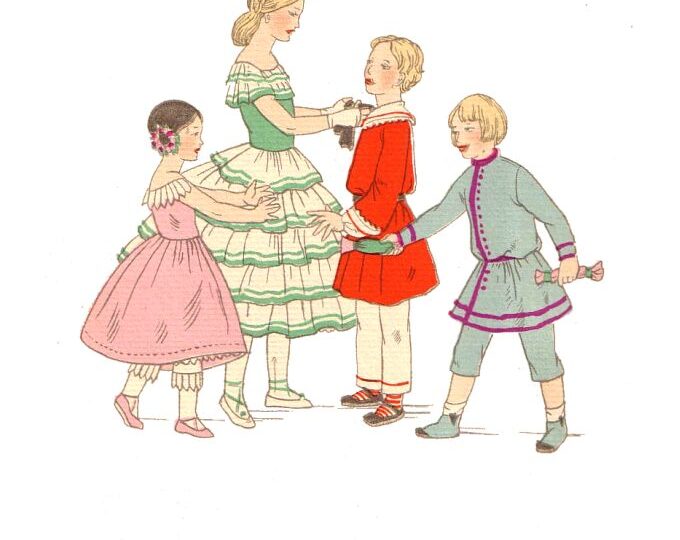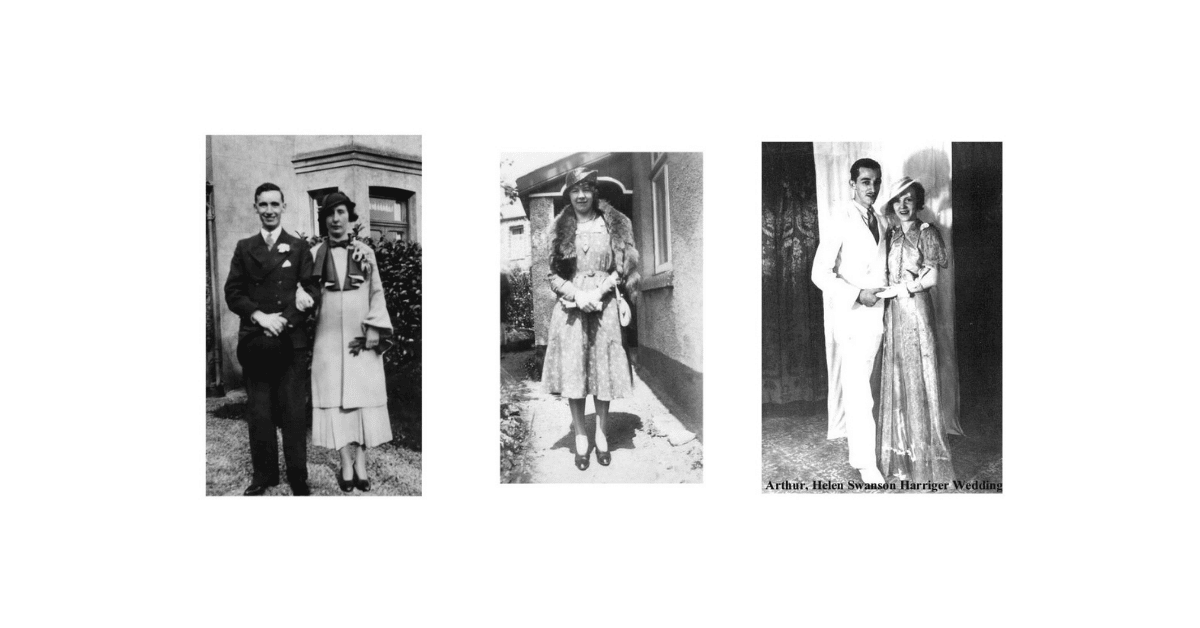By Pauline Weston Thomas for Fashion-Era.com
Girl's C18th, C19th & Early C20th Costume History General Information
- Little Women
- Silk Fabrics
- Less Formality in Dress for Children
- Aprons
- Girl's Clothes in the Early 1800s
- Typical Early C19th Fabrics and Fashion Elements
- Fashions for Girls in Early 1800s
- Fashions for Children After 1825
- Skirt Lengths and Styles for Victorian Young Girls
- Pantaloons and Pantelettes
- Polonaise Styles
- C19th Children's Fashion Fads - Tartan and Sailor Looks
- Early C20th Edwardian Fashions for Girls
- Hats
Little Women
For centuries little girls were dressed like small versions of their mothers. This dressing of children as miniature adults in every detail continued until the early C18th.
Formal paintings often show children in elaborate silk clothing with skirts supported by paniers and multiple petticoats.
Silk was an important fabric as it was used by the richer people in society to show off their wealth through their dress.
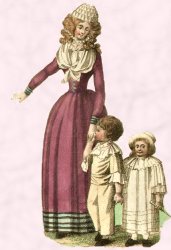
Poorer people whether adult or child wore simpler practical clothes made from linen, cotton, wool and lesser coarser fibres out of practical necessity.
Silk Fabrics
During the late 1600s the English Textile Industry began to produce cheaper silks in Britain in the Spitalfields part of London. This was because persecuted Huguenot designers and weavers had fled to Britain.
They brought their excellent silk production craft skills with them to the east end of London. These refugees were able to reproduce the highly ornate designs previously sourced from the continent at greater cost.
So wealthy children were dressed lavishly as many family portraits suggest. Poor children wore tattered hand me downs or clothes made of coarse woollens and rougher cottons or mixtures like fustian.
Less Formality in C18th Dress for Children
As the C18th progressed dress for both girls and boys became less formal and less stiff, giving way to more comfortable practical clothes children could move about in.
With the rise of the industrial revolution and relatively cheaply produced cotton goods children began to wear lighter weight softer washable cottons.
Aprons
Regency, Victorian and Edwardian girls all wore pinafores and smocks to cover up and keep clean their dresses. The volume of decoration of smocks, aprons and pinafores depended on the occasion. Party aprons being made of fine lace and heavily trimmed were ornate and lavish with embroidery.
Girl's Clothes in the Early 1800s
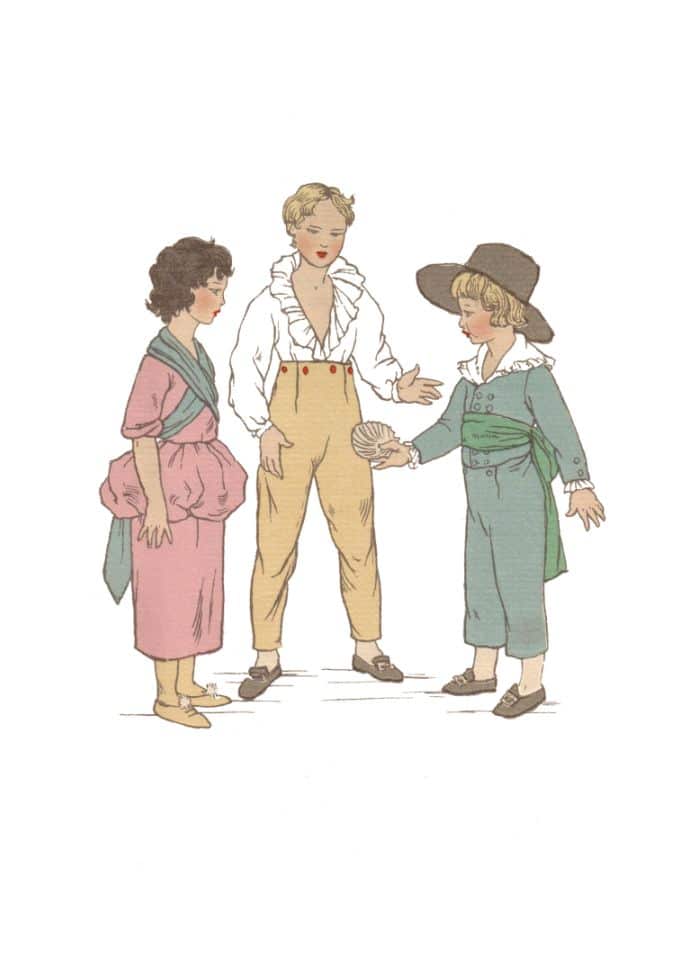
By the 1800s clothes for children were more relaxed in appearance, but so too were the fashions of adults of that era.
As the C19th moved on, children's fashions were often in imitation of adults, but were never so cumbersome as in previous eras. By the mid Victorian era children's clothes were often featured in fashion magazines and ultimately on fashion plates.
One feature common through much of the C19th were an under/outer garment called pantelettes.
Children's Clothing in the 1800s Typical Early C19th Fabrics and Fashion Elements

In the early 1800s, as soon as they were running around, girls wore dresses of muslin, dotted Swiss, white percale, lawn and nankeen - a yellow buff coloured fabric from China.
Empire line gowns following the fashion of the day were usual. Simple lightweight muslin dress styles with a high cut empire line bodice seam of the early 1800s were worn with a slip. The dress was drawn together with a ribbon or sash just beneath the chest.
These dresses right in the painting called 'The Sisters' circa 1800, are very typical of muslin and fine lawn fashions that adults of the early C19th wore. (This painting is attributed to John Opie 1761 to 1807 and also John Hoppner 1758 to 1810),
Fashions for Children After 1825
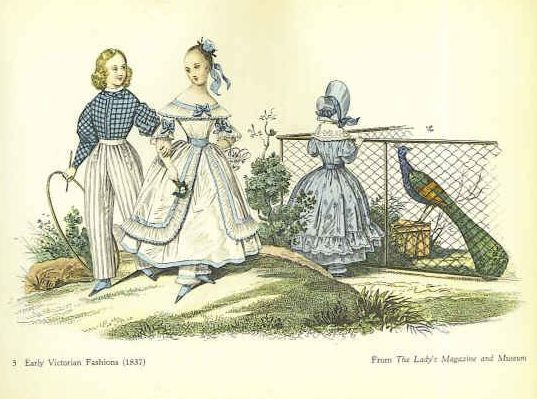
By 1825 fashion conscious elements had crept back into the styles and girls soon looked liked mini adults again.
Fashion trimmings returned with a vengeance in the Romantic era. Profuse decoration in the form of ruffles, flounces, and fur trims with the waistline moving down in the same ways as adult dress had, was topped by ornate hats and bonnets.
The gigot sleeves of adult women were repeated in the styles of girl's dresses.
The skirt length on an individual child was a sign of her age. This lovely fashion plate right is from a book sold by an antiquarian Fashion Books bookseller Jon Edgson at eBay. This image shows children of 1837 and you can see how closely these children look like mini adults of the era.
As children's clothing has evolved over time, so too has kids costumes as you can see here. Today there are many options for consumers to choose when it comes to costumes for children. One great source is Halloween Express.
Skirt Lengths and Hoop Styles for Victorian Young Girls
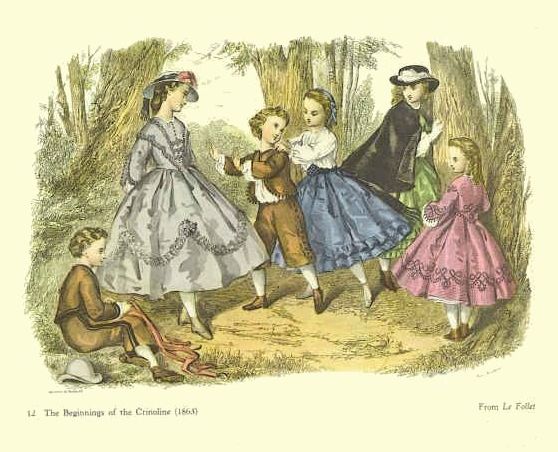
In the C18th all girls wore floor length gowns. In the early 1800s young girls began to have their skirts shortened.
A seventeen and eighteen year girl was considered to be a young lady and wore skirts ground length just like adult women did. Most sixteen year old wore gowns to the ankles, a fourteen year old skirts to the calves, but a 12 year old wore skirts to just below the knee.
Not even the youngest child escaped the wearing of a crinoline supported skirt. By the 1840s those skirts were true crinoline style. They were pushed out with stiff starched petticoats and horsehair crin fabric petticoats in layers. Later a wire hoop cage crinoline, a mini version of adult crinolines, liberated youngsters as it made lighter work of the job.
This image is of a fashion plate dated 1863 and from Fashion Books at eBay.
Pantaloons and Pantelettes
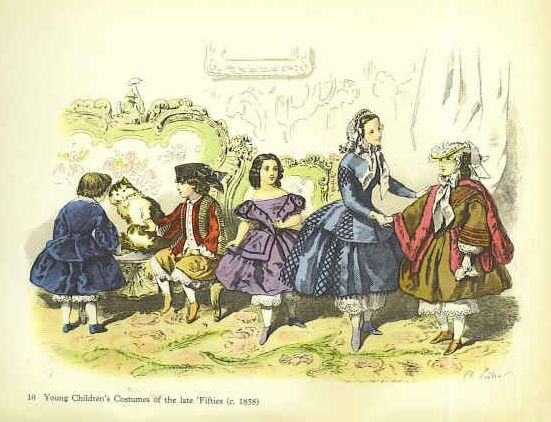
Modesty meant that all girls wore long full length pantaloons beneath these skirts so that onlookers saw glimpses of lace white frill peeping beneath hemlines.
A breeze or gust of wind could easily tip a crinoline off balance and reveal legs, but ones fully clothed in broderie anglaise. Even the poor followed this fashion and used a simpler leg covering of white linen or cotton frilled tubes which were called pantelettes.
The visibility of these items actually became a fashion. Other undergarments meant to be seen included drawers with attachment legs for easy laundering and to accommodate lengthening.
This image is of a fashion plate dated 1863 and from stock held at Fashion Books at eBay.
Polonaise Styles
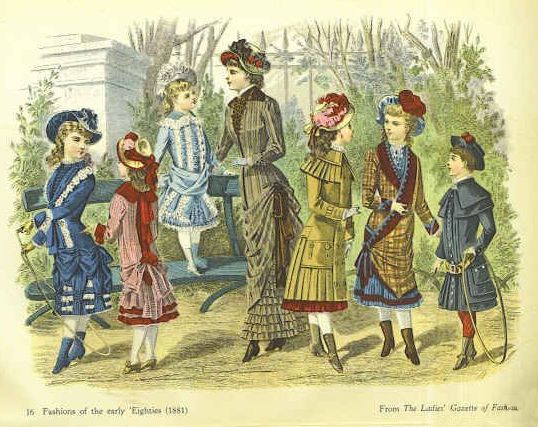
Just as the crinoline on adult dress moved toward the garment back so did the crinoline on little girl's dresses. When the adult bustle came into fashion little girls wore long waisted dresses atop a false pleated skirt.
This fashion and variations of it for 30 years or so. This fashion plate of 1881 to the right is from a book sold from Fashion Books at eBay.
It shows how the dress of girls followed the slimmer styles of the early 1880s. As time passed this style continued but with the top part of the dress often bloused over a deep dropped waist sash. It heralded the S-bend pouched blouse adult styles of the Edwardian woman.
By the time of the second bustle girls sometimes wore a softer less restrictive polonaise lighter weight version. Despite the fact that there was often a strong resemblance to adult female dress there is no doubt that garments for girls although still restrictive by today's standards had progressively become lighter and less cumbersome.
C19th Children's Fashion Fads - Tartan and Sailor Looks
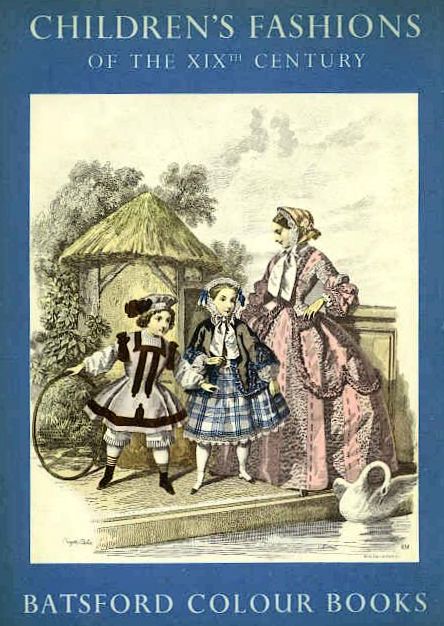
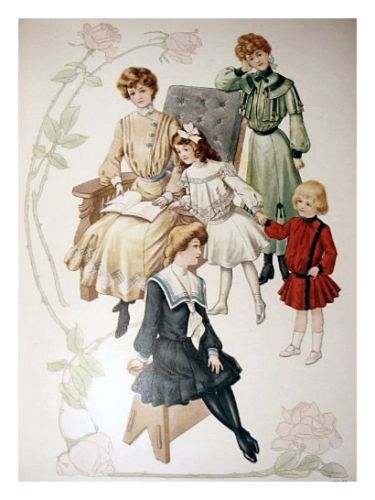
Various fads of fashion with children's clothing included a love of tartan fabrics or sailor elements. If you click this thumbnail right left you will see the tartan dress more clearly.
This children's fashion history book is typical of books sold by UK seller Jon Edgson at the Fashion Books shop at eBay.
Sailor styles in various forms were especially popular once the seaside visit became the norm.
Large sailor style collars and contrast rows of braiding decorated both girls and boys clothing through the late Victorian and Edwardian eras.
Quartermaster jackets were also worn over a plastron dickey false front instead of over a complete blouse. These last two illustrations show the large collars and jabots.
Early C20th Edwardian Fashions for Girls
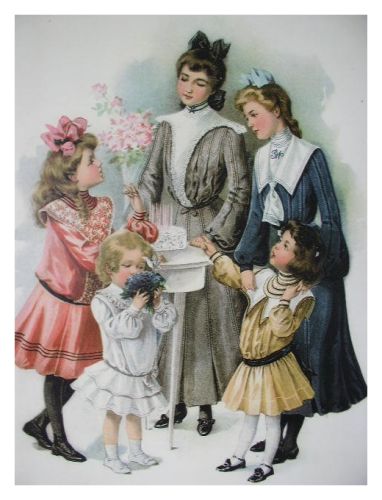
Ornate frilled dresses for girls of age 5 or more were popular in the early Edwardian years.
Often the dresses had a heavily frilled yoke and either a flowing smock skirt, which ended in a frill, or a bloused bodice.
The dress might be either loosely bloused, or bunched with a sash into a blouson low waist effect.
Flounces were popular too as skirts layers or as a decorative trim.
Hats
Throughout the C19th girls wore lavish flower and ribbon trimmed hats or bonnets always when out of doors.
On occasion when dressed for school, outdoor walking or when wearing sailor dresses, they also wore berets or pompom finished tam-o'shanters.
Right girl wearing a red coat and a tam o'shanter in 1916.
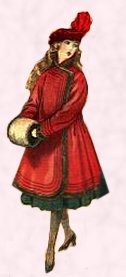
The children's costume colouring-in pages in this section, reflect the variety of clothes styles that girls mostly wore through the Regency, Victorian and Edwardian eras.
My thanks for use of images to UK seller Jon Edgson of Fashion Books where you will find a continuous and varying collection of fashion history, costume history or textile related books.
Please note this site DOES NOT provide information on Boy's costume in any way.
This Children's Costume Drawing and Fashion Page Updated Sept 2006
Late Regency Children's Clothes 1820-1830
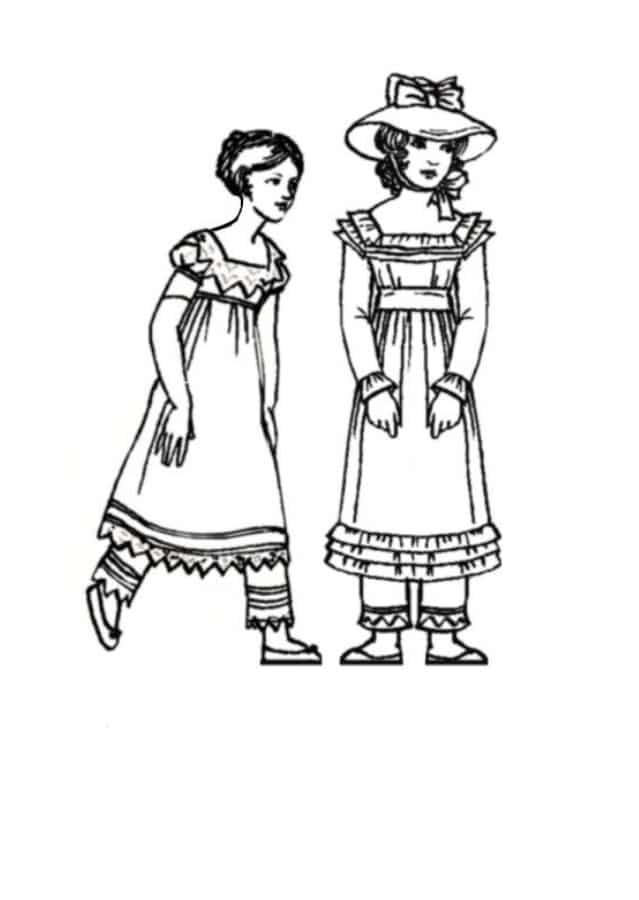
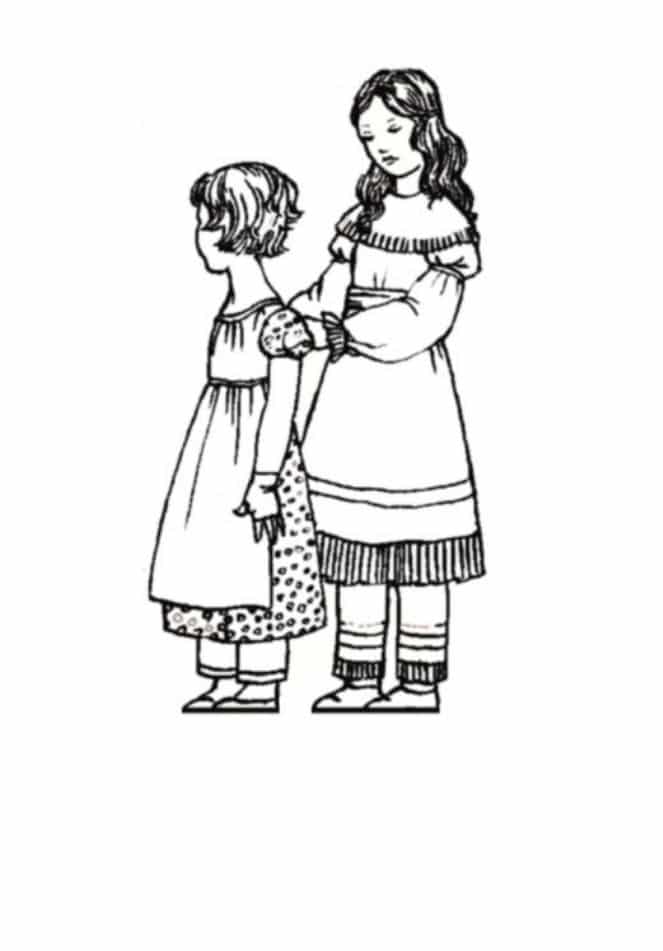
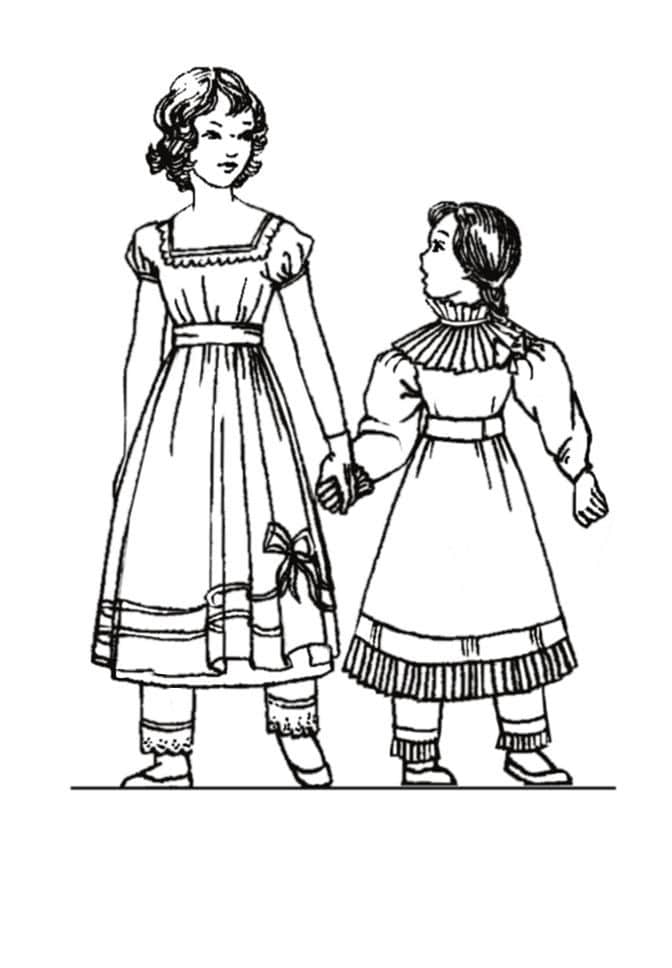
Skirts started to get much shorter and fuller and more heavily decorated with tucks, braiding and pleated trims. Girls all wore pinafores and smocks to cover up and keep their dresses clean.
Even the poor followed the fashion for pantaloons and used a simpler leg covering of white linen or cotton frilled tubes which were called pantelettes.
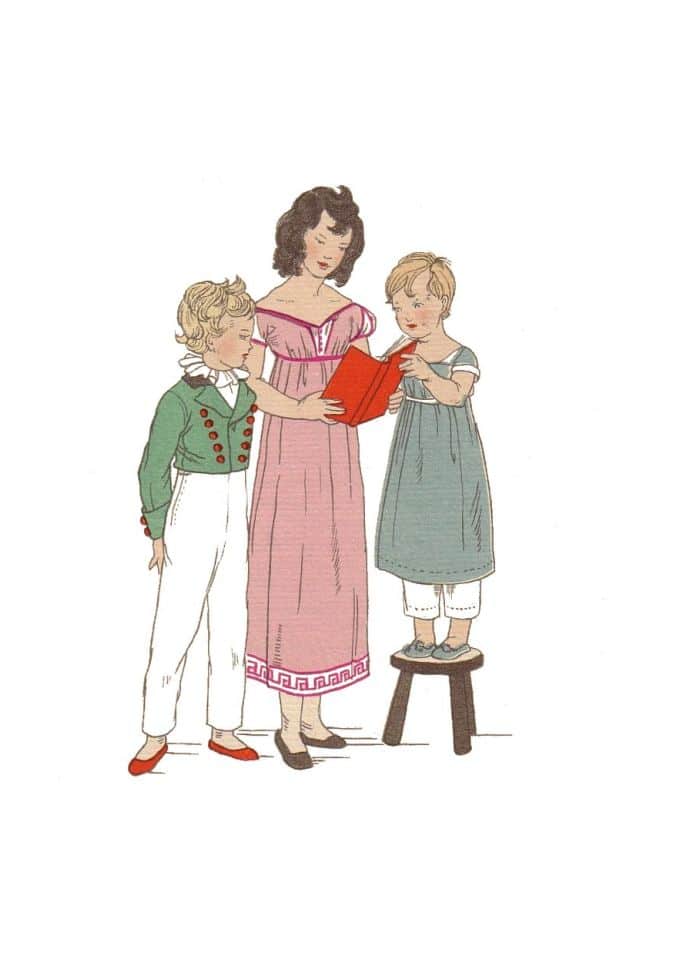
The visibility of these items actually became a fashion and pantaloons were designed to match the main frock.
Other undergarments meant to be seen included drawers with attachment legs for easy laundering and to accommodate lengthening.
Flimsier fabrics were replaced by heavier materials and in deeper colours than the whites, ivories and pastels that had been so usual.

The sturdier fabrics enabled sleeves to be made with greater fullness and was the start of the gigot leg o'mutton sleeve to come.
I've studied costume drawings from a book I have dated 1930 and made my own simplified drawings (mainly of girls in costume) but using felt pens. These produce a heavier outline suitable for children to colour in and keep within lines.
Early C19th Children's Fashions 1830 to 1840
These costume colouring in pictures reflect the variety of clothes styles girls mostly wore.
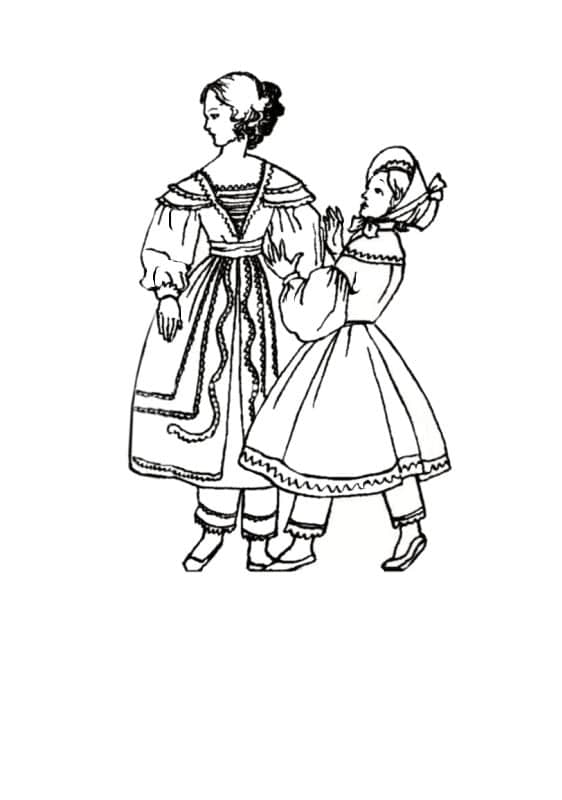
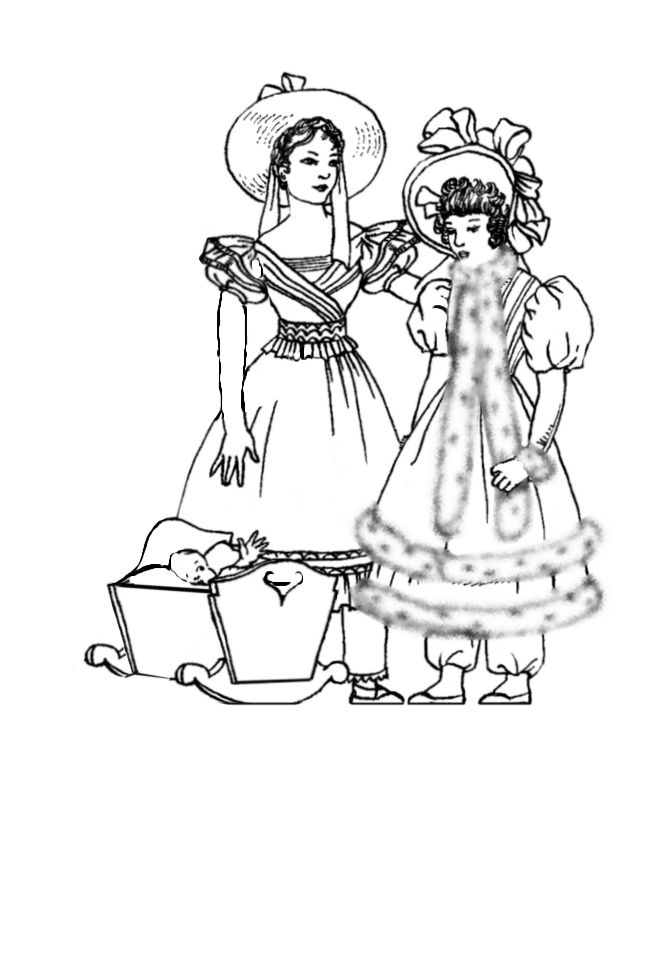
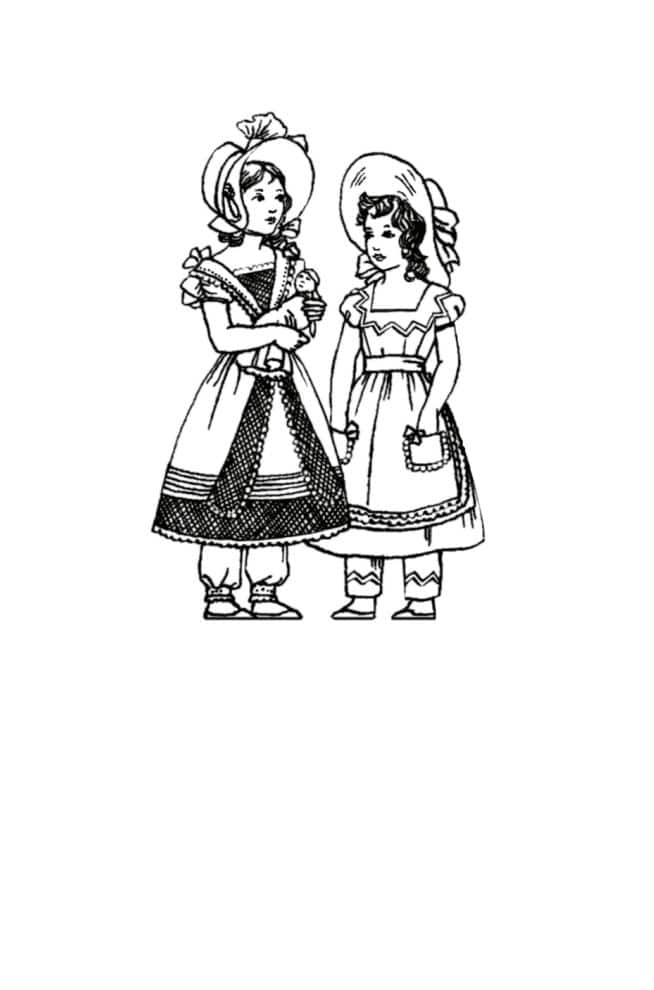
Hats began to get larger as the skirt width increased and by 1830 were of huge proportions for a small child. As the decade progressed smaller bonnets were worn.
Bonnets though were generally oversized and over decked with flowers and ribbons. The only way to keep them on such active wearers was with masses of string ribbons.
Sleeves called Leg o'Mutton sleeves also increased greatly in volume. They helped balance the skirt widths which were supported by four or five corded heavily starched petticoats.
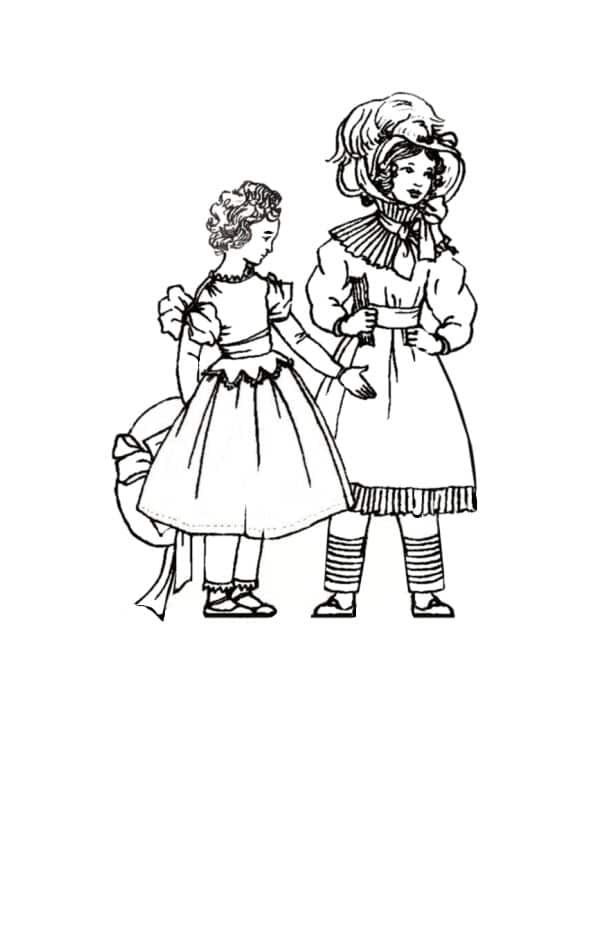
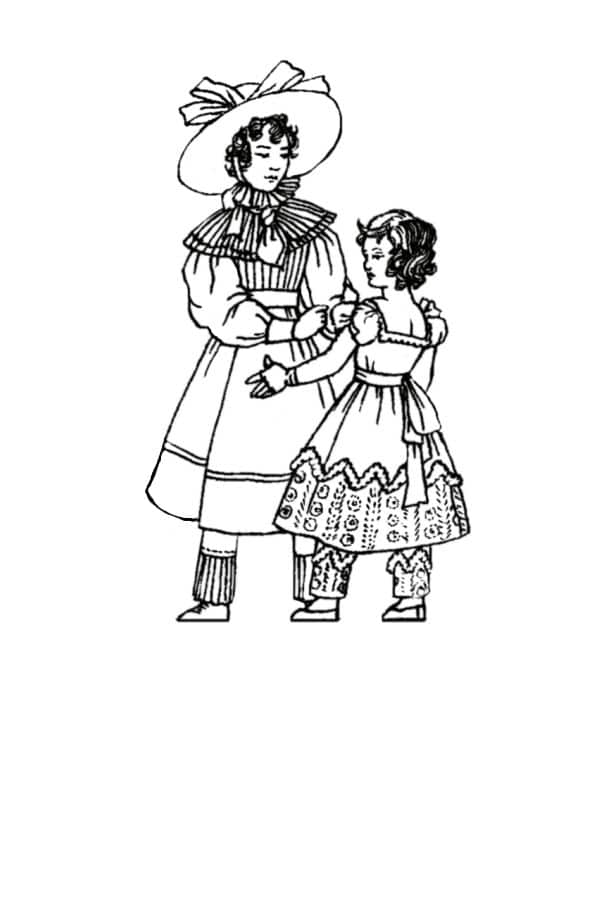
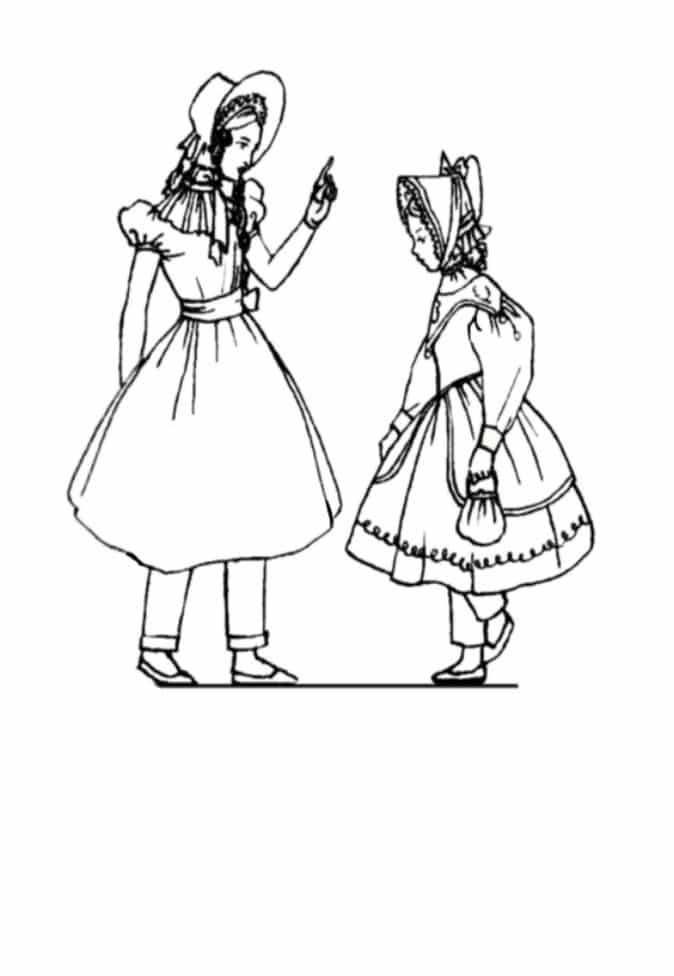
One of the most fashionable collars is the stand up pleated ruff collar a form of pelerine collar as shown in the two images left above.
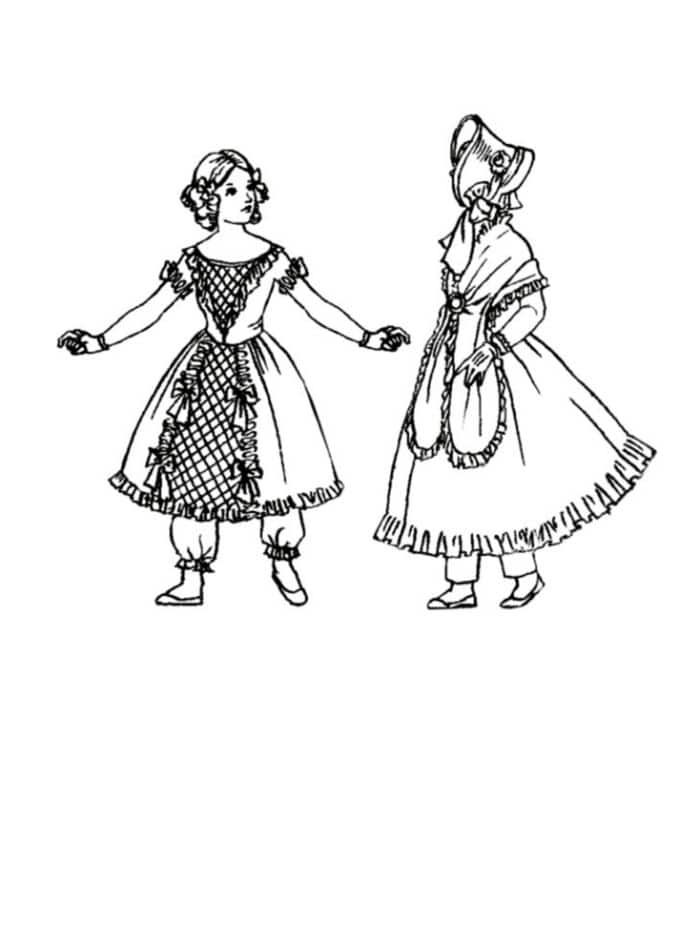
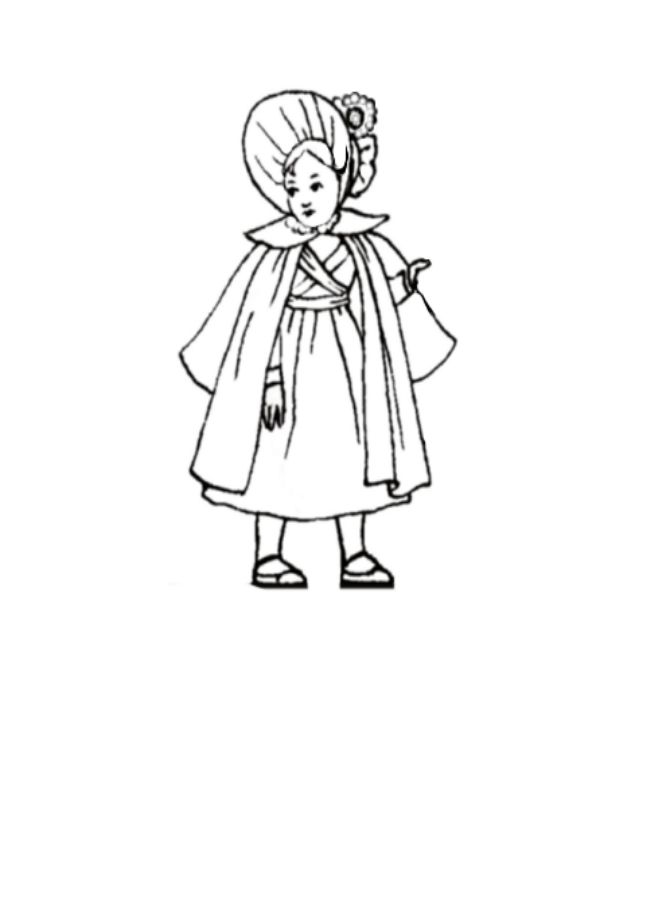
Gradually the fullness of the leg o'mutton sleeve subsided and a shorter tighter sleeve was more popular by the later 1830s. although large oversized collars were abandoned they were replaced by softer garments called pelisses.
Pelisses were shawls made mostly from cashmere and as in the last example above often sported small frills or even fur trims. By 1840 girls had longer hair and it was being centrally parted a fashion set by the young Queen Victoria.
Other fashions started by the queen were the use of tartan fabrics and tartan was used extensively in children's dress for both girls and boys.
As clothes became more voluminous capes were popular forms of mantle cover ups.
I've studied costume drawings from a book I have dated 1930 and made my own simplified drawings (mainly of girls in costume) but using felt pens. These produce a heavier outline suitable for children to colour in and keep within lines.
This Children's Costume Drawing and Fashion Page Updated Sept 2006
Victorian Children's Costume 1840-1850
These costume colouring in pictures reflect the variety of clothing girls mostly wore. Here you can see how the trend is toward fuller skirts.
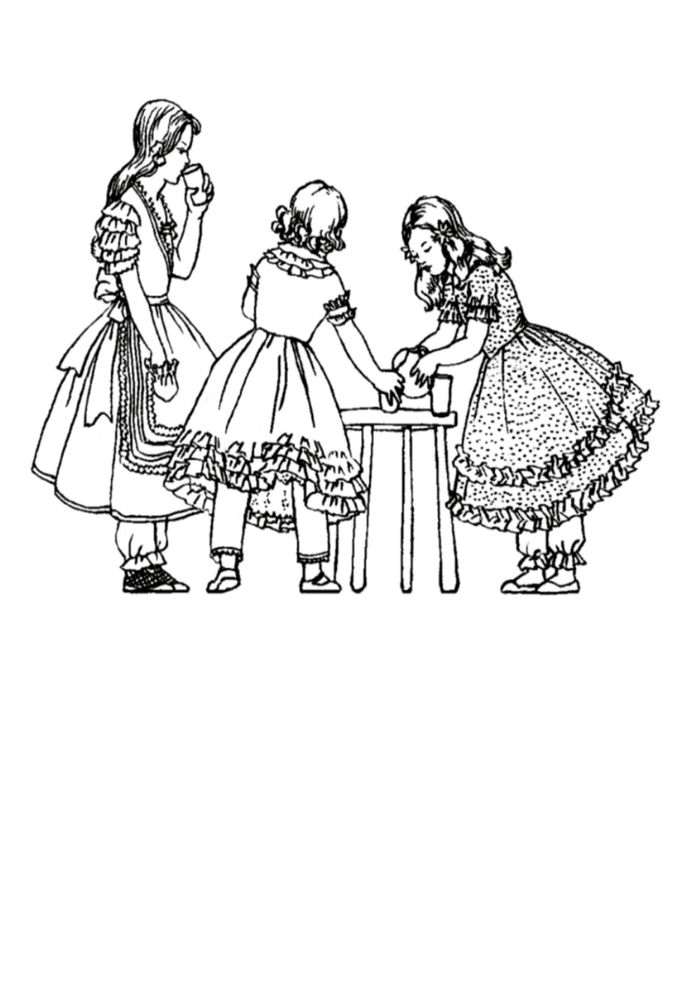
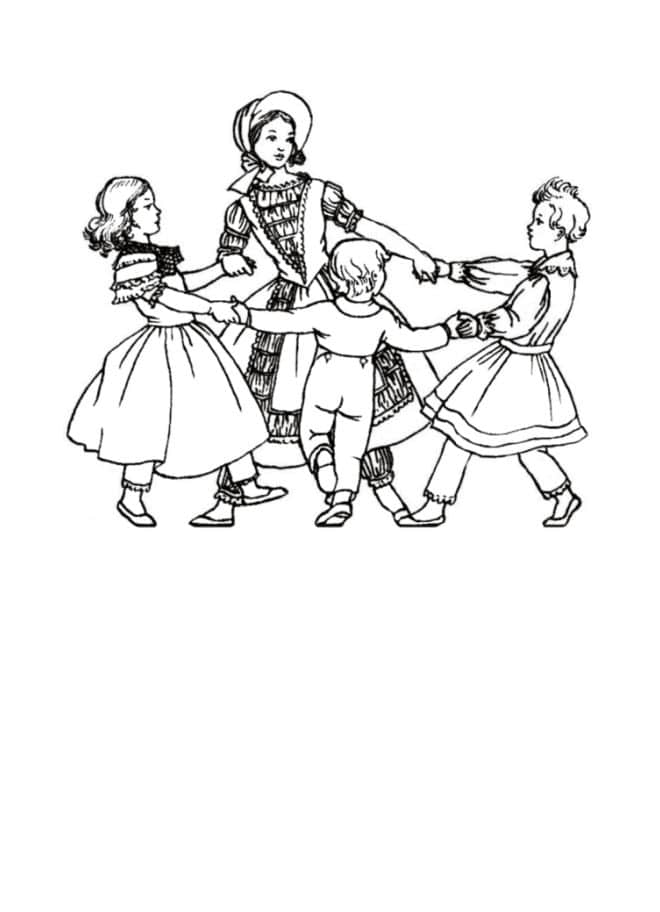
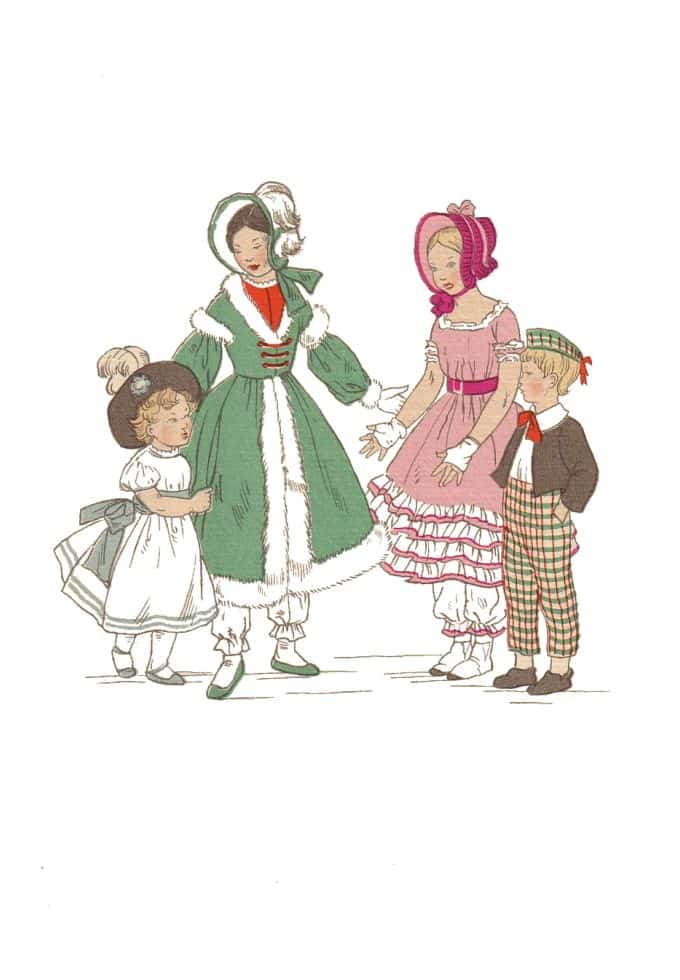
By 1840 dresses for children were waisted again. Plush fabrics like velvet trimmed with fur, taffeta and glace silk were all popular choices for wealthier parents.
In the early 1840s the bodice style was straight at the waistline, but watch how this element changed in a few years. Fashionable tucks were used on both hemlines and sleeves, but edges were often trimmed with pretty hand made lace.
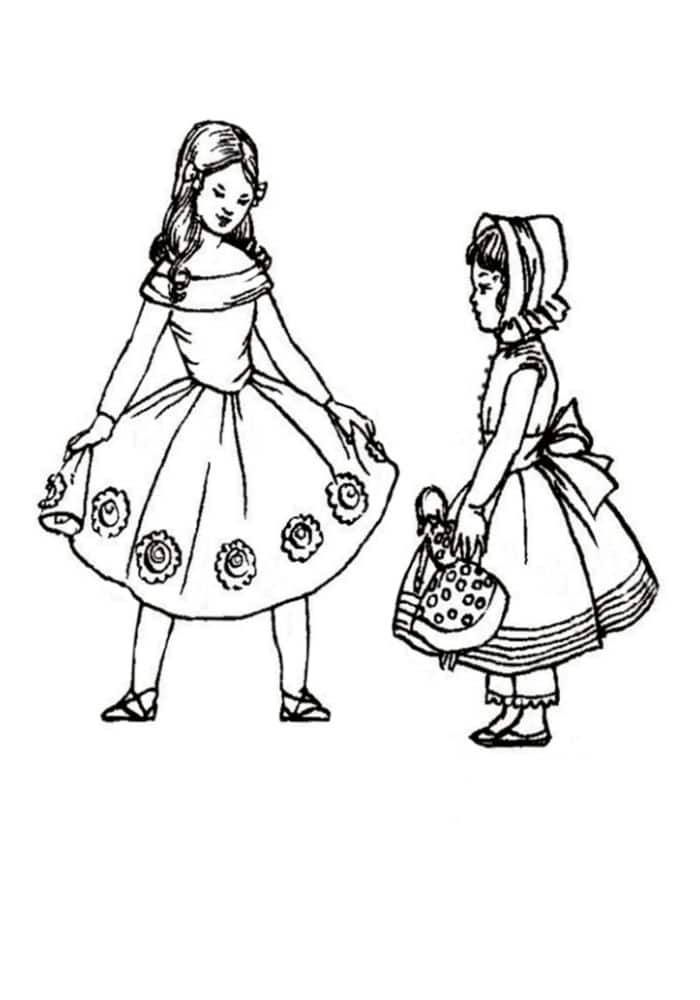
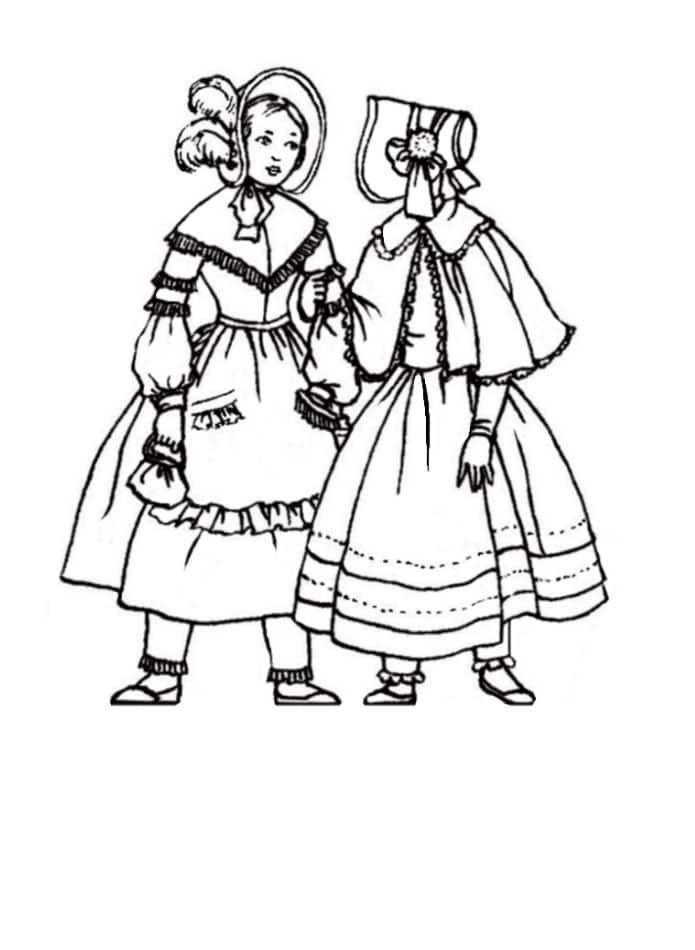
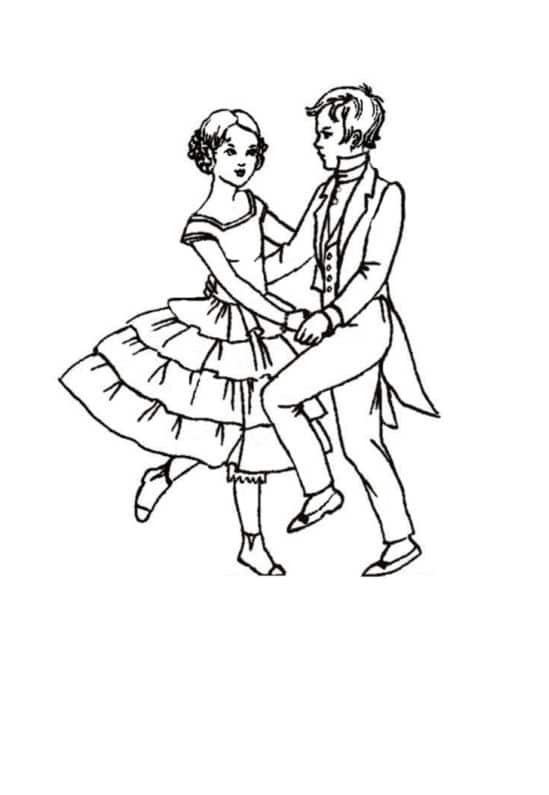
The skirt on the 1850 dress below was very large and needed lots of good horsehair crinoline and corded petticoat support.
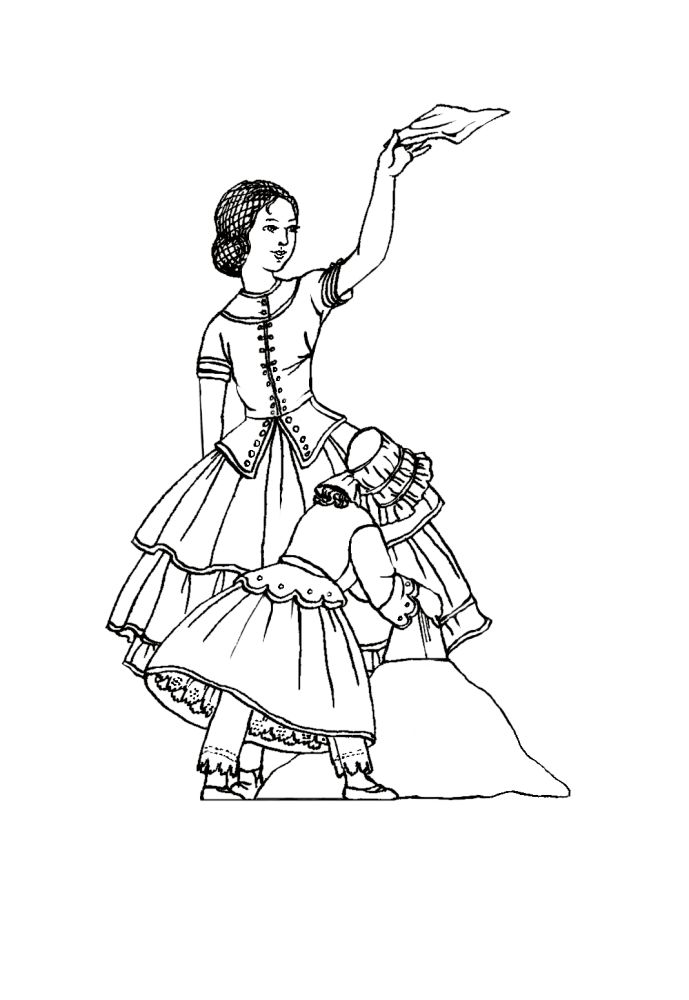
The dresses these girls wore are called dresses, but are quite certainly made of two pieces.
The separate bodice coat of the small girl was waisted.
It had a short peplum or basque with the newer bell sleeve that revealed a glimpse of the blouson under sleeve.
Her short pantaloons were mostly covered by the skirt.
I've studied costume drawings from a book I have dated 1930 and made my own simplified drawings (mainly of girls in costume) but using felt pens. These produce a heavier outline suitable for children to colour in and keep within lines.
1850 to 1860 Early Victorian C19th Children Clothes
These victorian children's clothing images reflect the variety of clothing styles girls mostly wore.
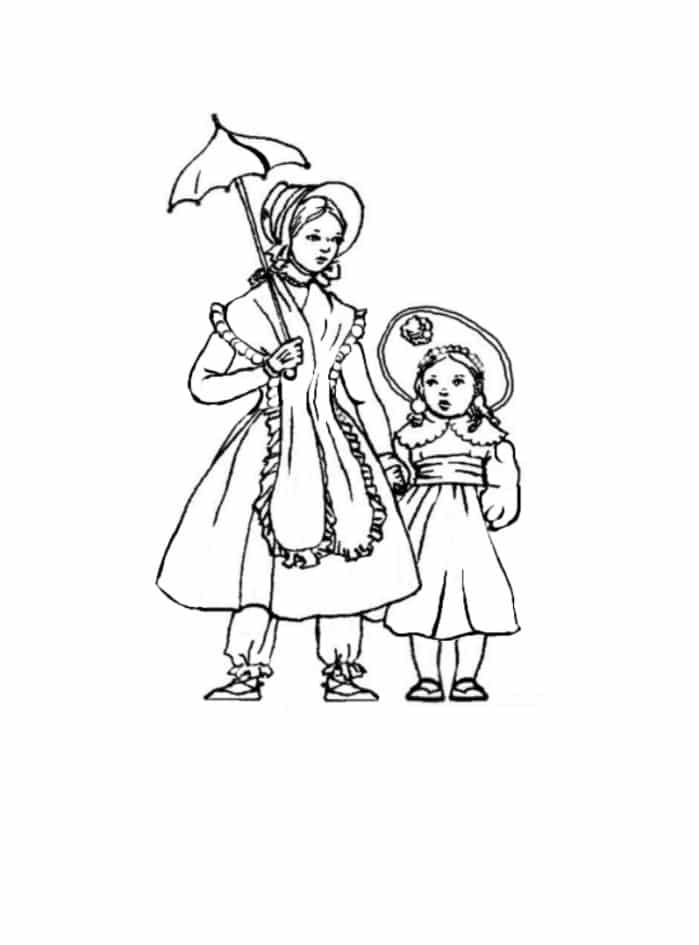
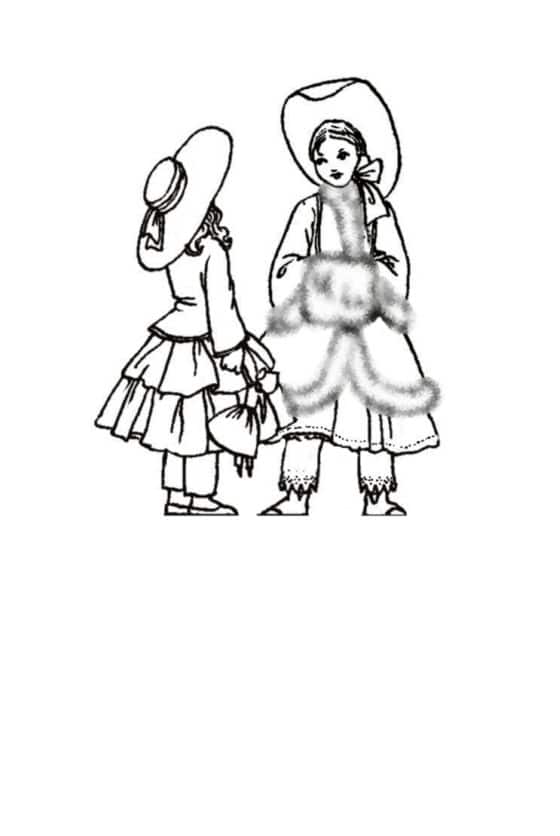
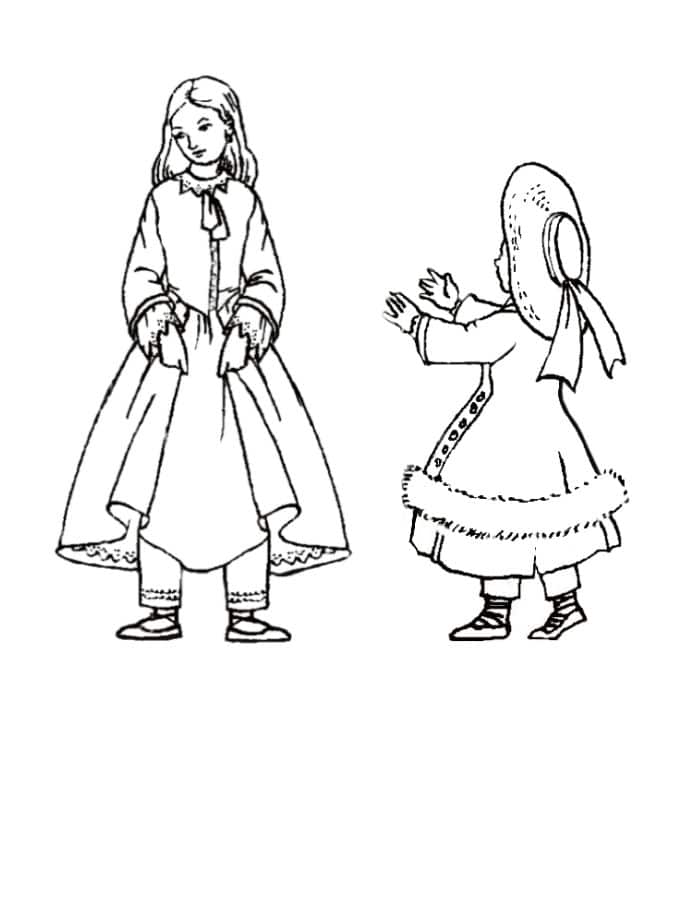
The bigger hat of the early 1850s balanced the wider fuller skirts that were very large. Poke bonnets were soon ousted in favour of these large wheel hats of leghorn straw worn far back on the head. They were held on with ribbons at the chin.
Girl's hairstyles changed too and side plait coils held at ear level were often trimmed with imitation flowers. Toward the decade end hats got smaller.
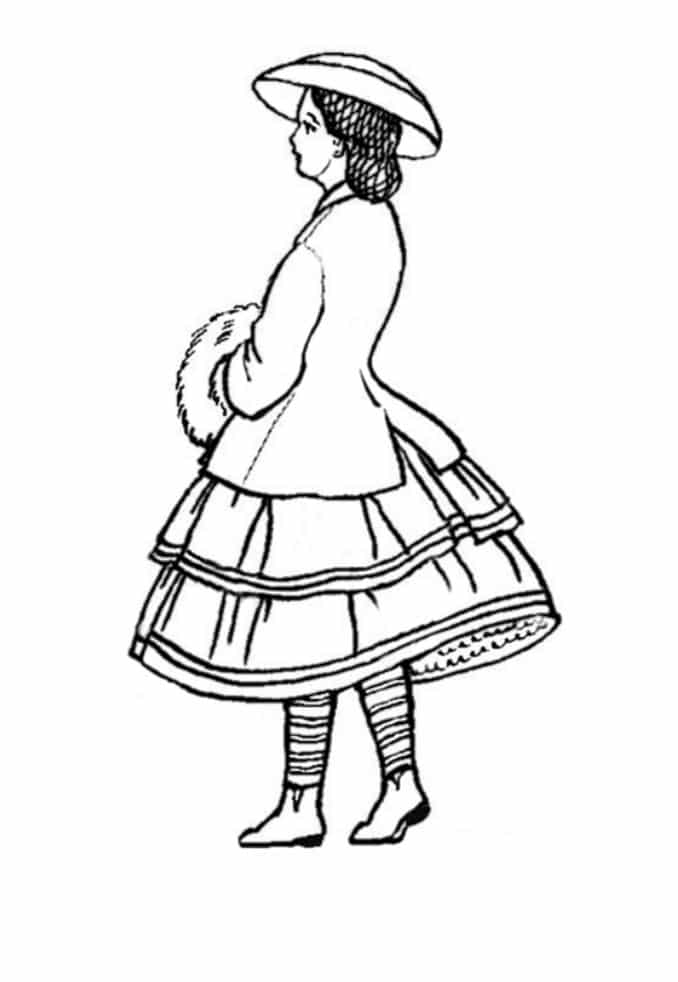
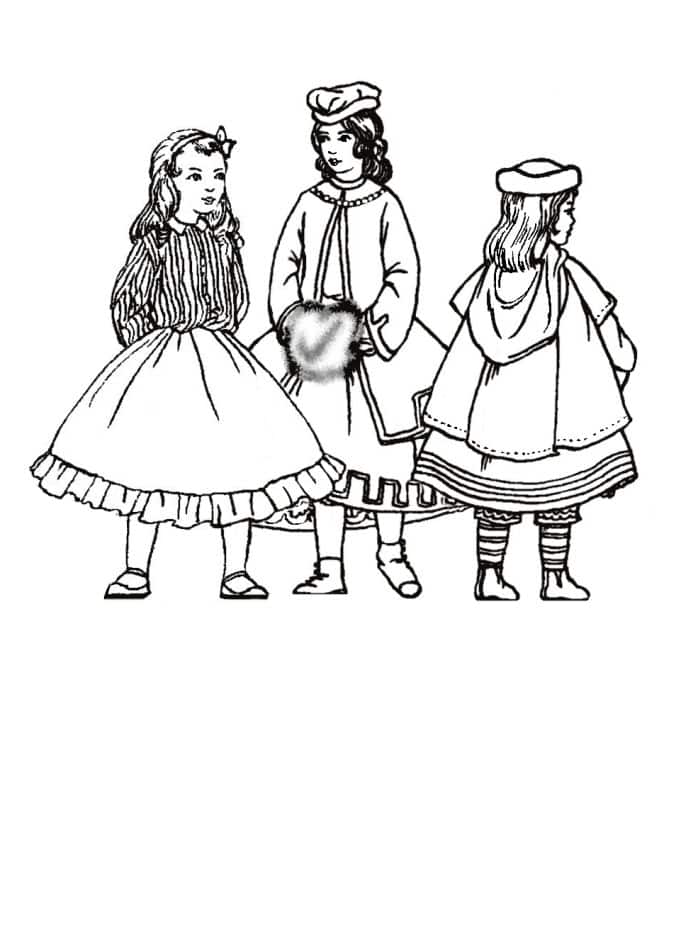
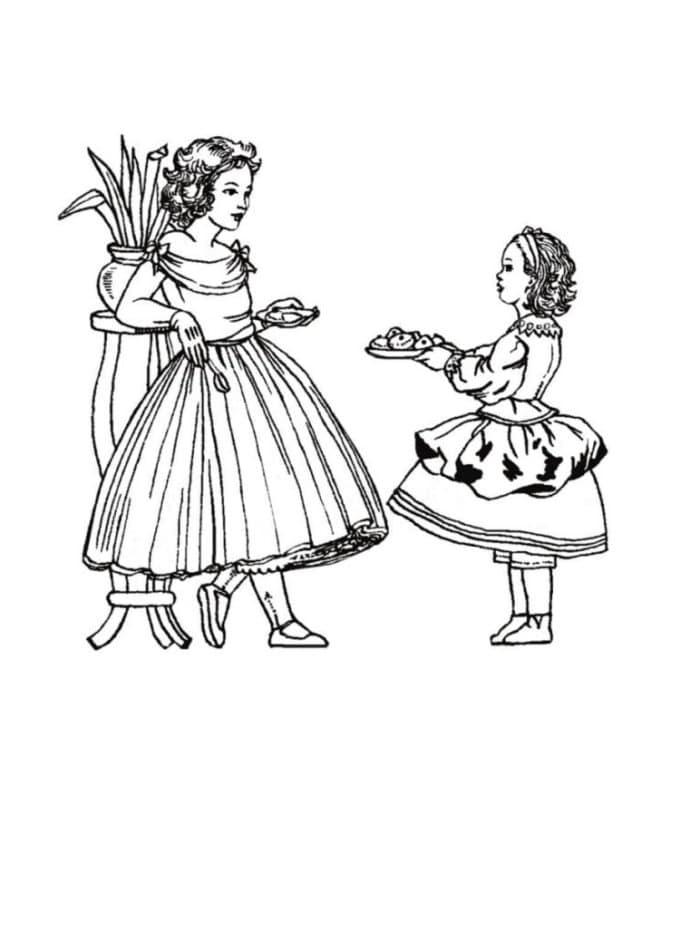
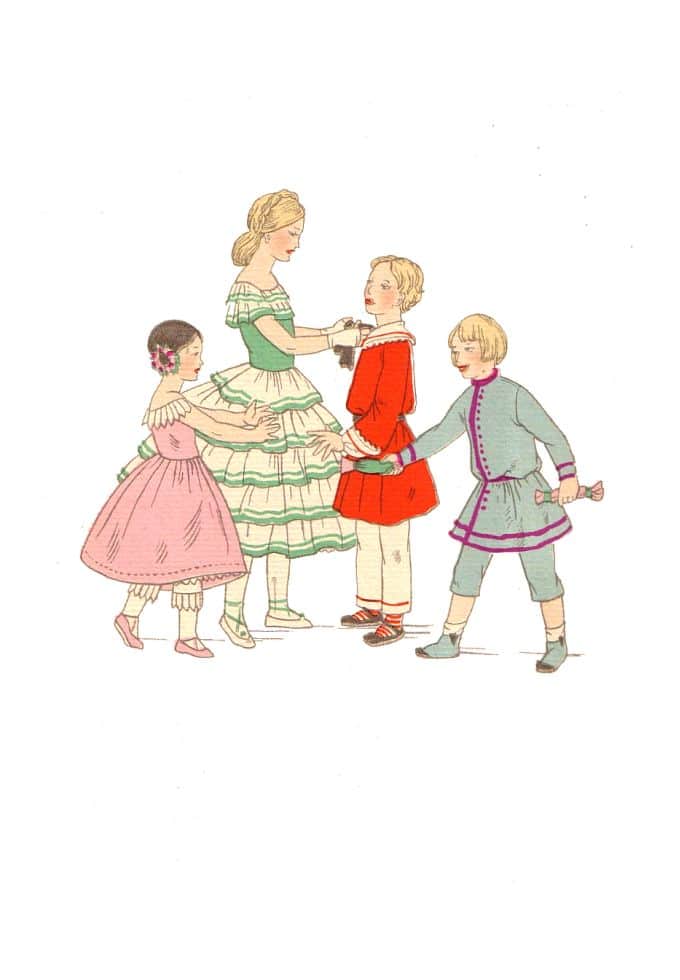
Most children's sleeves of 1855 were the new bell shape. Muffs were popular and so were fur trims, tucks, and frills.
By late decade the girl's crinoline was very large even for small girls and often had an extra bunched up skirt like the end image.
I've studied costume drawings from a book I have dated 1930 and made my own simplified drawings (mainly of girls in costume) but using felt pens.
These produce a heavier outline suitable for children to colour in and keep within lines.
Colouring in Pictures of Mid Victorian Children's Clothes 1860-1870
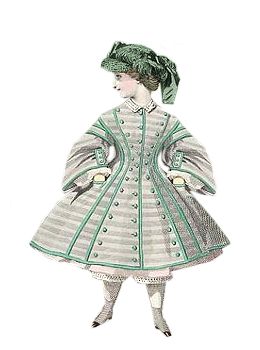
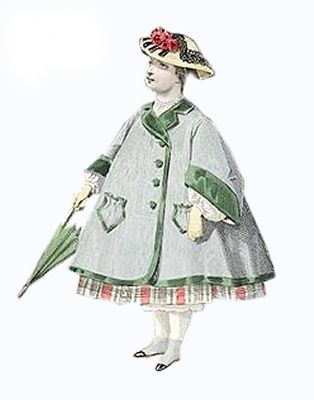

By late decade the crinoline was very large and often had an extra bunched up skirt like the first image.
The skirt became a complete dome reaching huge proportions by the mid 1860s. Skirts were trimmed heavily with rows and rows of braiding.
The skirt fullness began to move toward the skirt back.
The bell sleeves developed a deep cuff and later became straighter and narrower appearing more close fitting.
Little girls often wore puffed short sleeves.
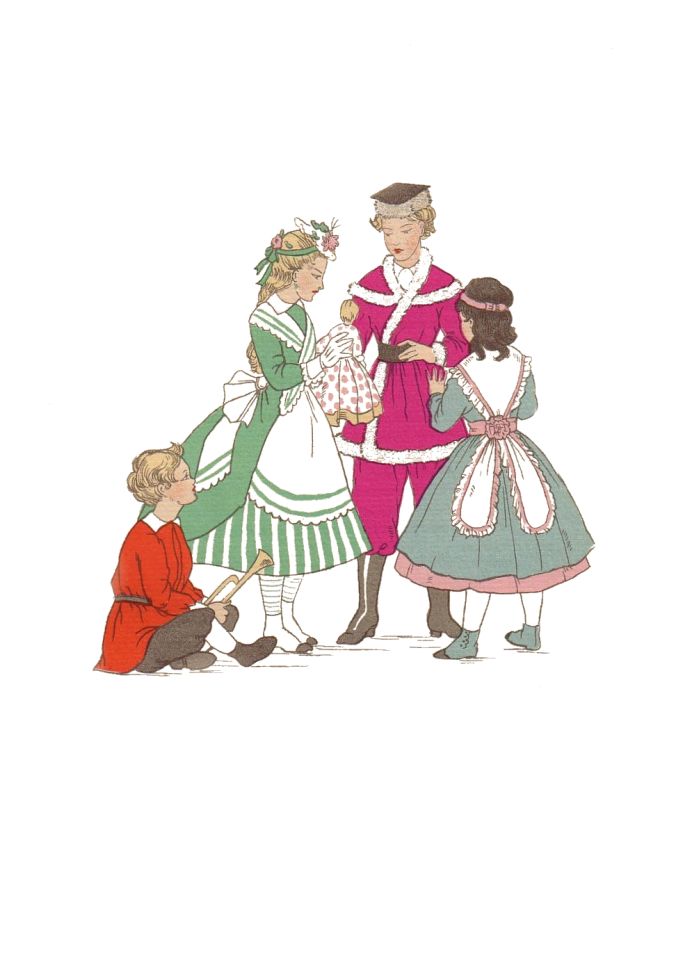
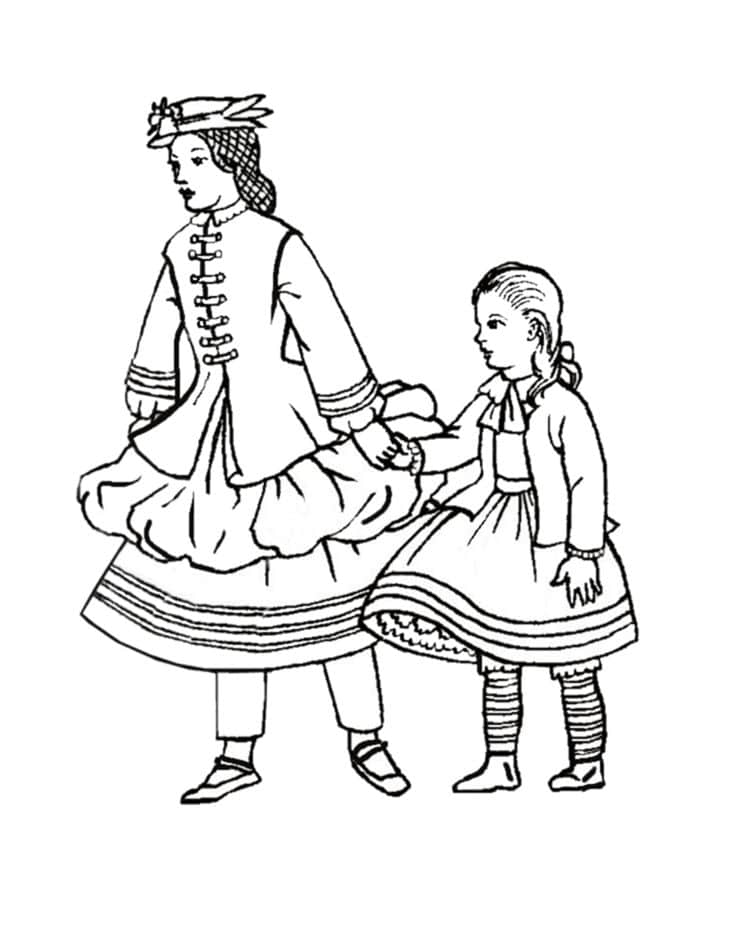
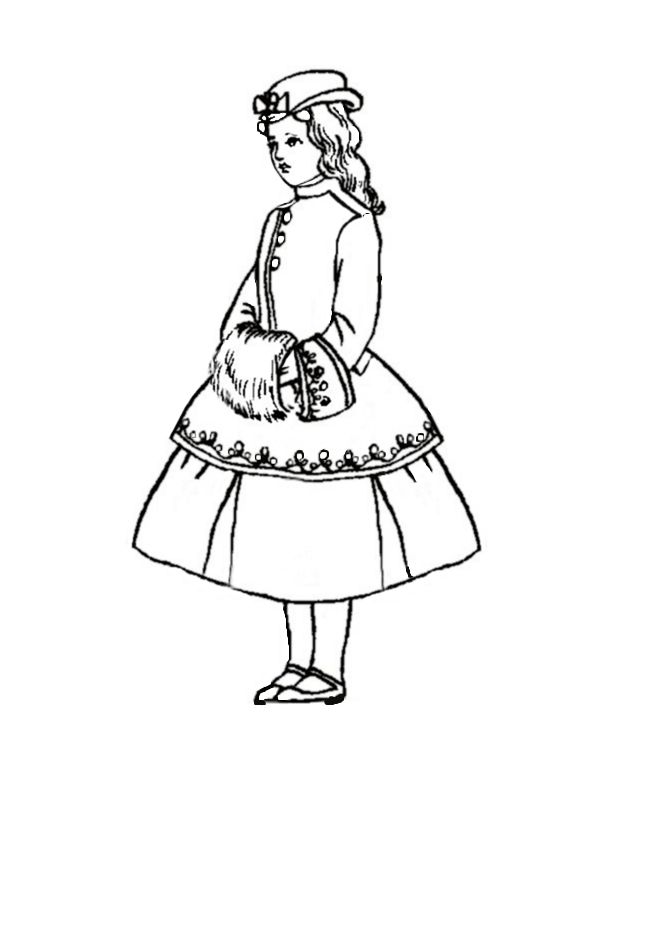
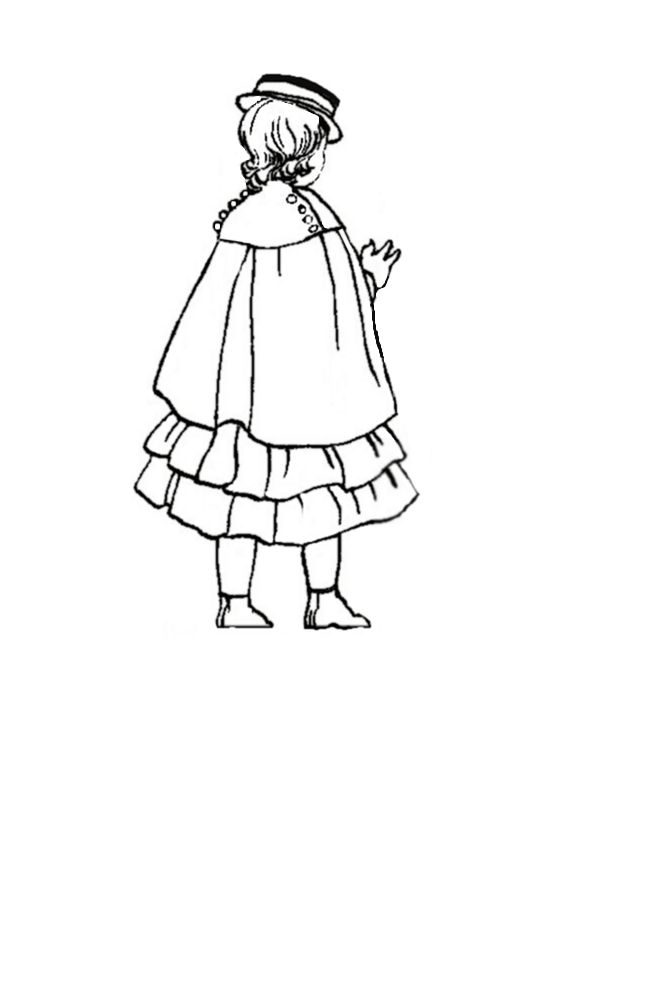
Easy cover ups included hooded capes. Bodices frequently follow the Garibaldi fashion with a little bunching at the waist.
Importantly pantaloons went right out of fashion and the latest underwear for fashionable girls was a small cage crinoline.
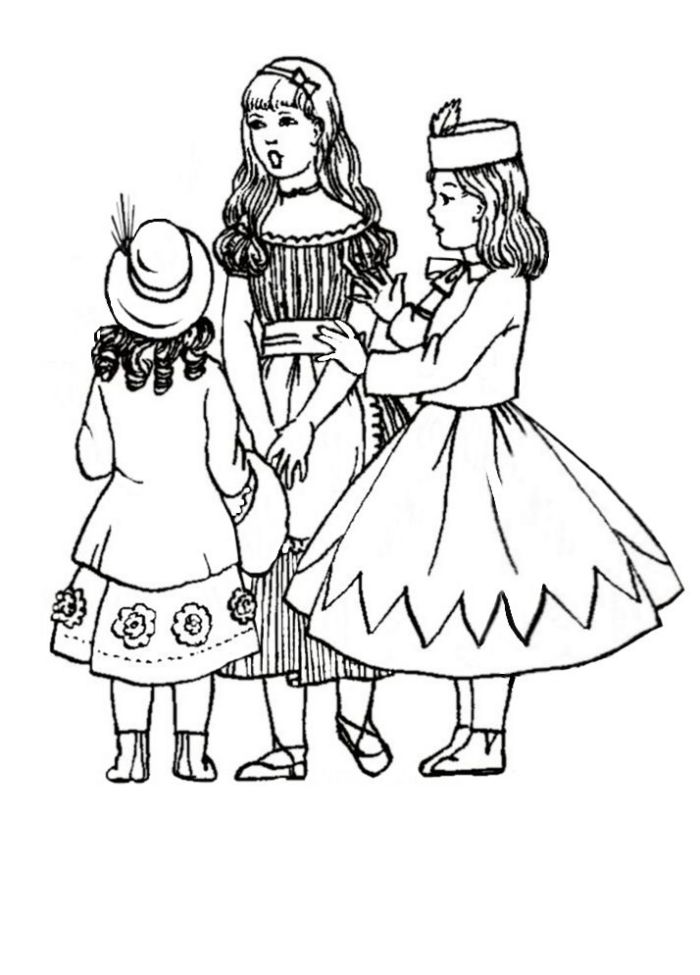
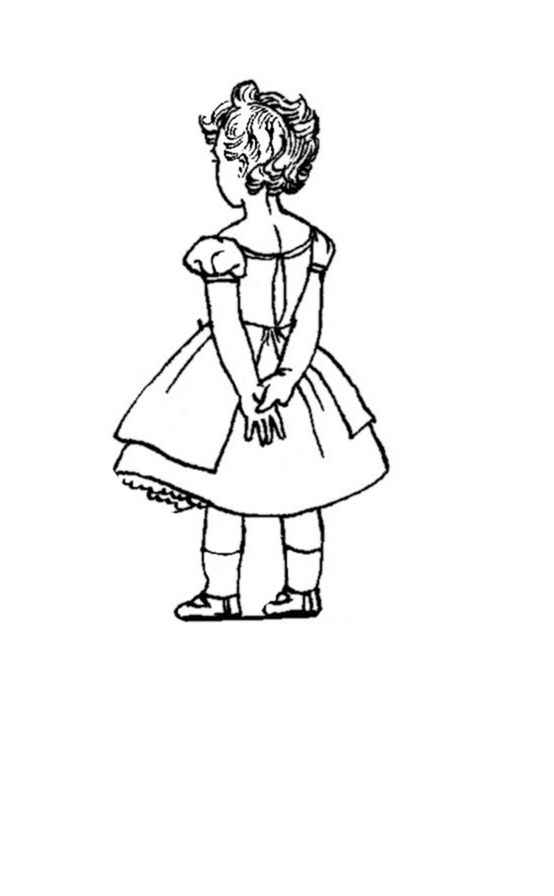
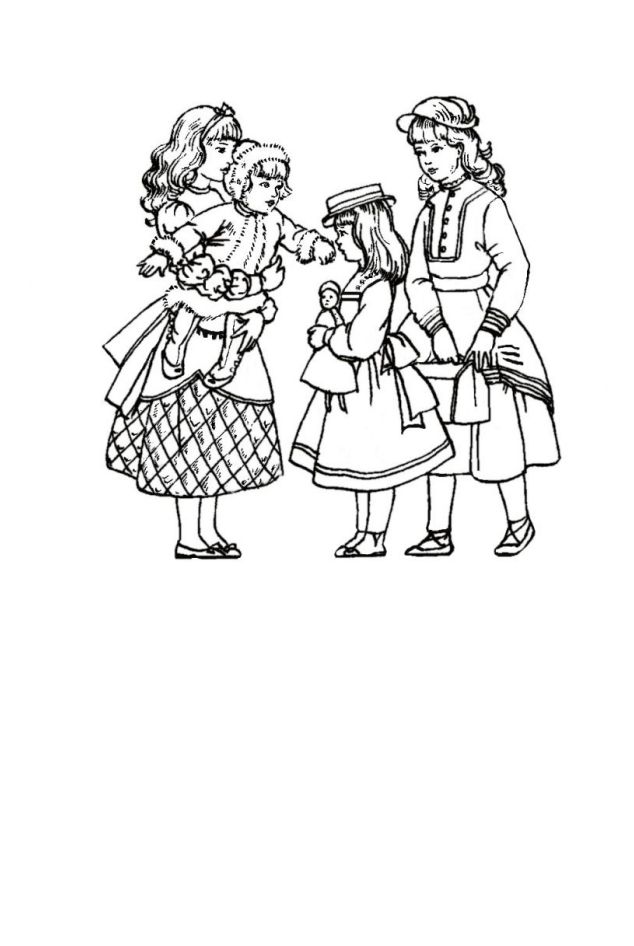
The hats were also scaled down and pork pie styles were trimmed with feathers. Hats became much smaller, boaters or cap like tams. Longer hair was often dressed with snood nets before 1865, but after that the chenille netting used disappeared.



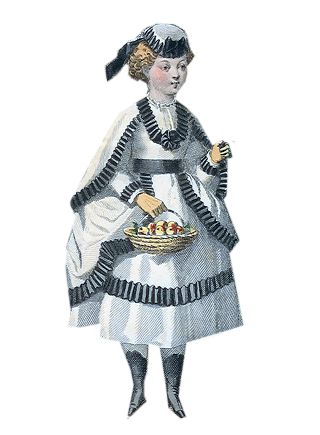
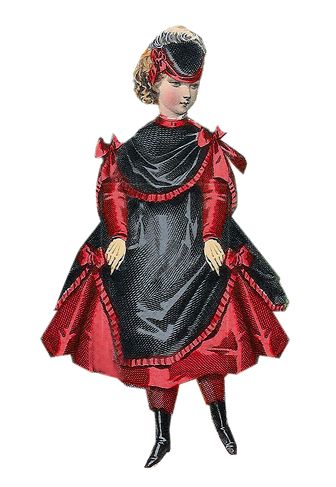
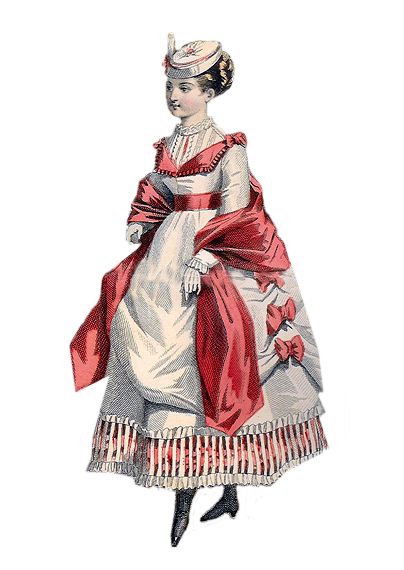
Hairstyles changed to hair brushed back off the face and held in place with a velvet ribbon in true Alice style. Fringes adorned the heads of late 1860s children.
The skirts began to move toward the garment back as seen in the last image with apron effect.
Colouring in Pictures of Mid Victorian Children's Clothes 1870 to 1880
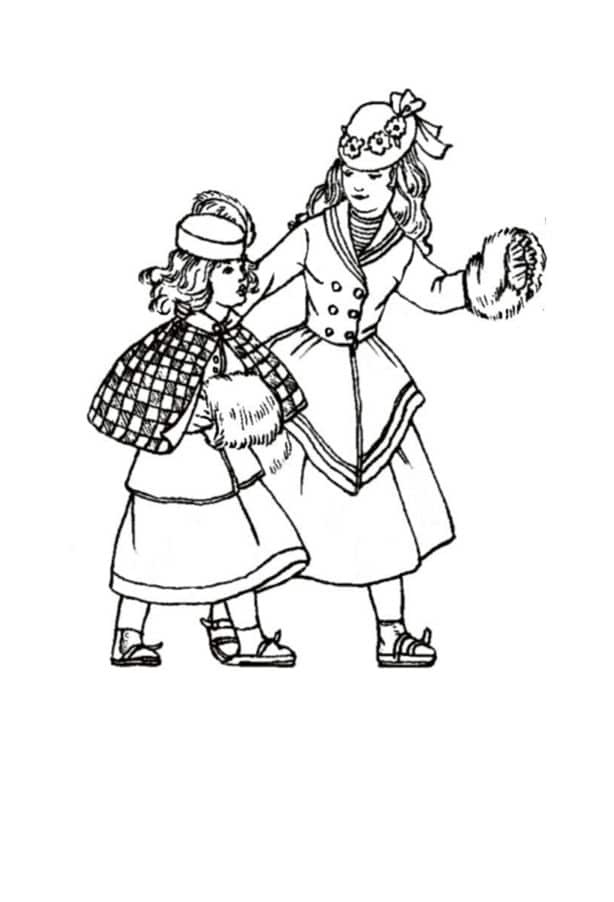
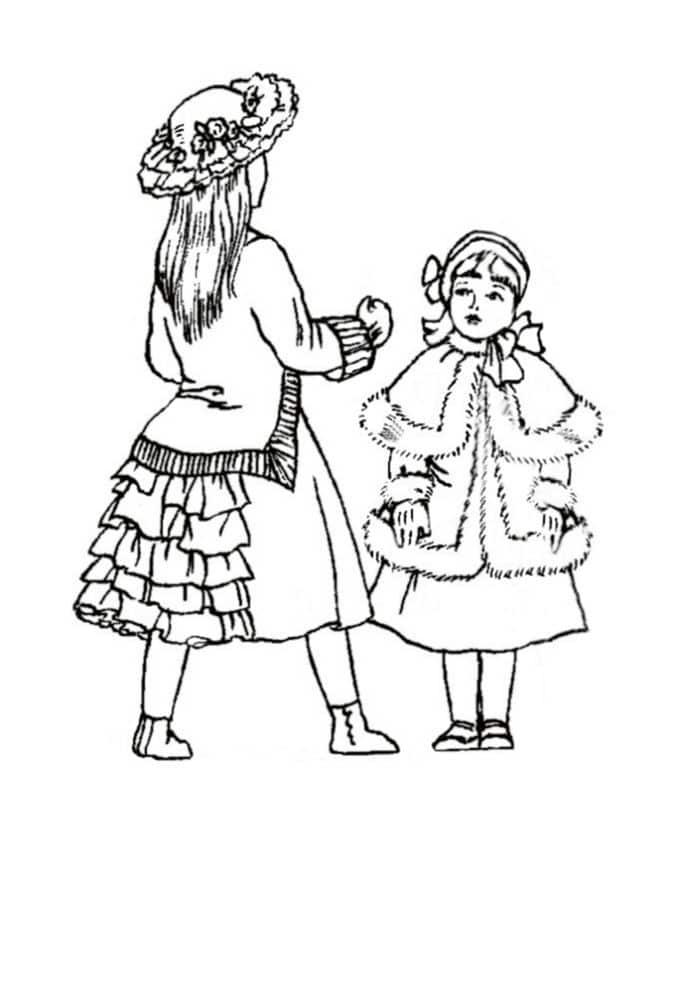
The invention of aniline dyes meant that garish colours were used on children's clothing. Puce, plum, scarlet red and navy were all strong colours of the era. Corded petticoats were used to support dresses which began to show soft bustle/polonaise element as the skirt was bunched up.
Girl's hairstyles of the 1870s all sported the fringe.
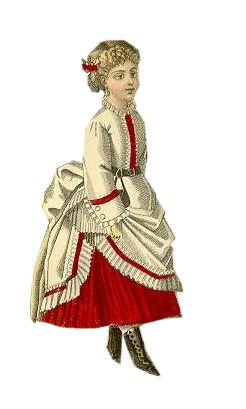
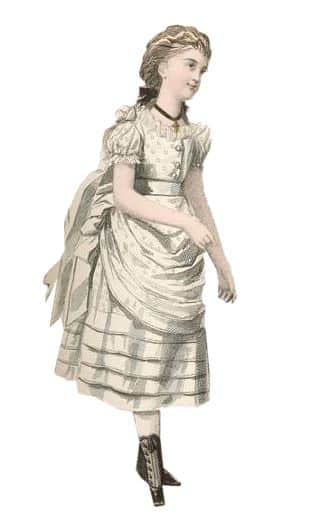
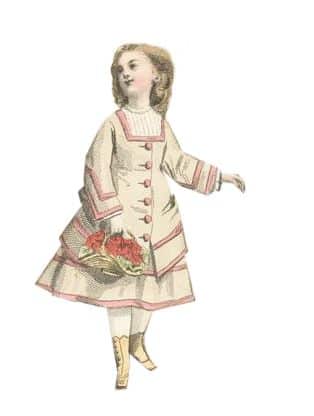
Another popular mass invention was the sewing machine and this enabled garments to be even more profusely decorated with extra frills and pleats or other weighty trimmings.
Braids and buttons were used equally lavishly, but the high bodices were almost always collarless. Almost all dresses were finished with a large sash ending in a fulsome bow.
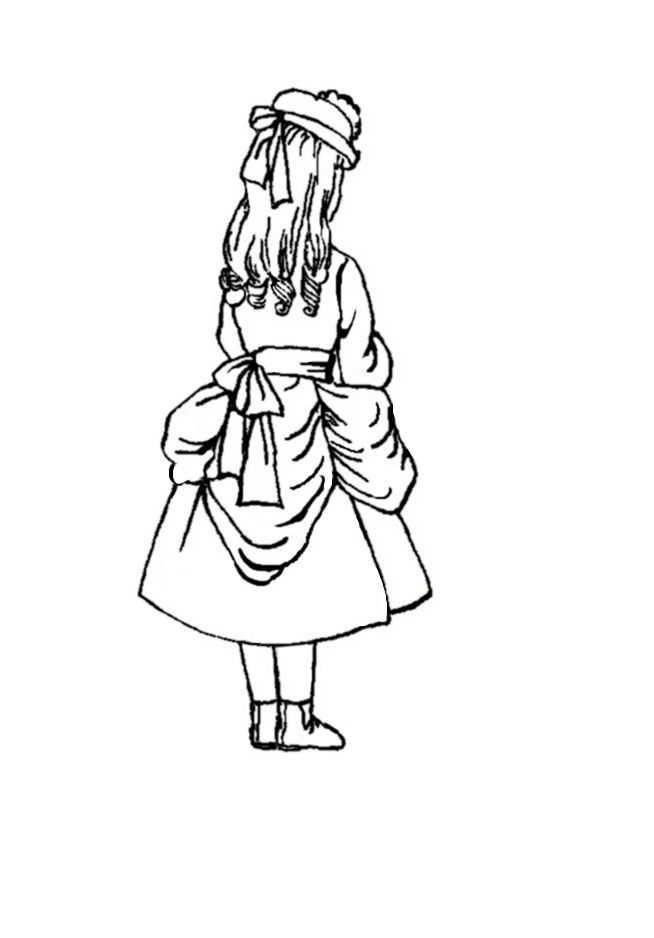
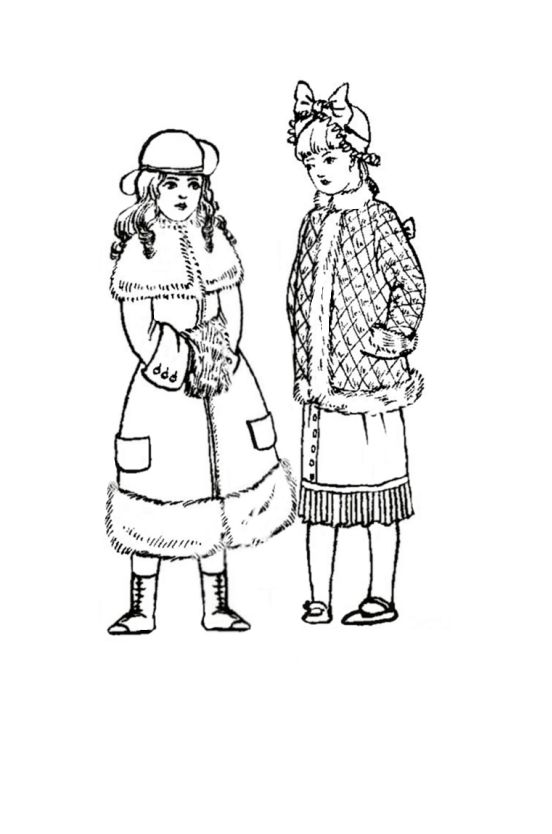
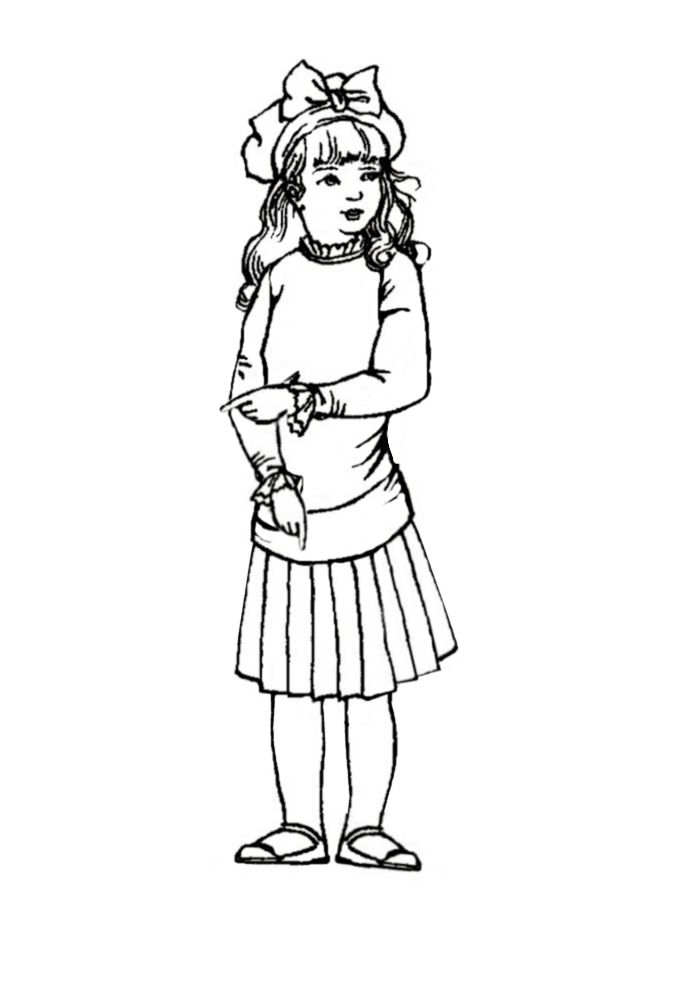
Long cloaks were reduced in length to a much shorter cape and often they were of fur or tartan checks. Fur muffs were an essential accessory for the well groomed child of the 1870s.
The tiny hats were saucer sized and were perched atop the head until the mid 1870s when they began to get larger again. Sleeves remained straight, but often had large cuffs or deep cuffs heavily decorated with buttons and braids.
By 1880 a favourite form of dress for girls was the kilted skirt and hip length bodice over tied with a deep sash.
Late Victorian Children's Clothes 1880 to 1890
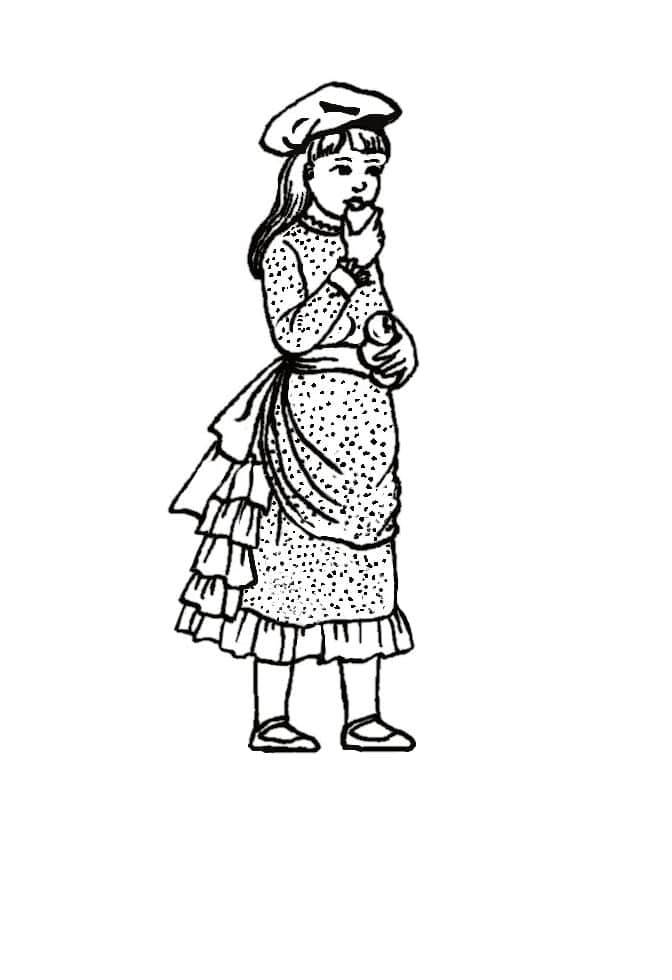
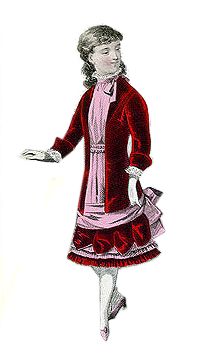
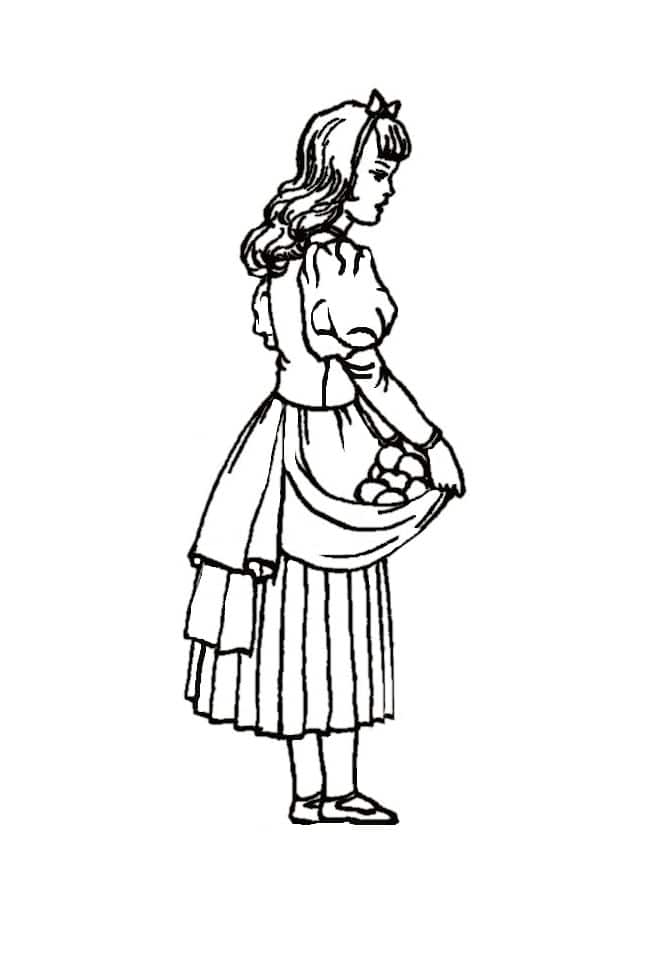
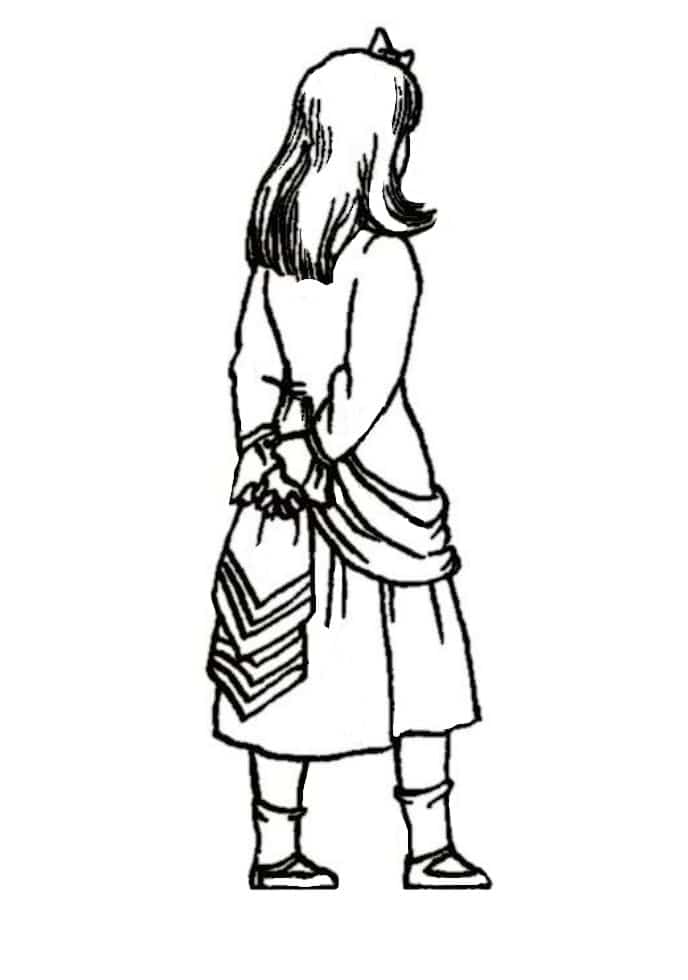
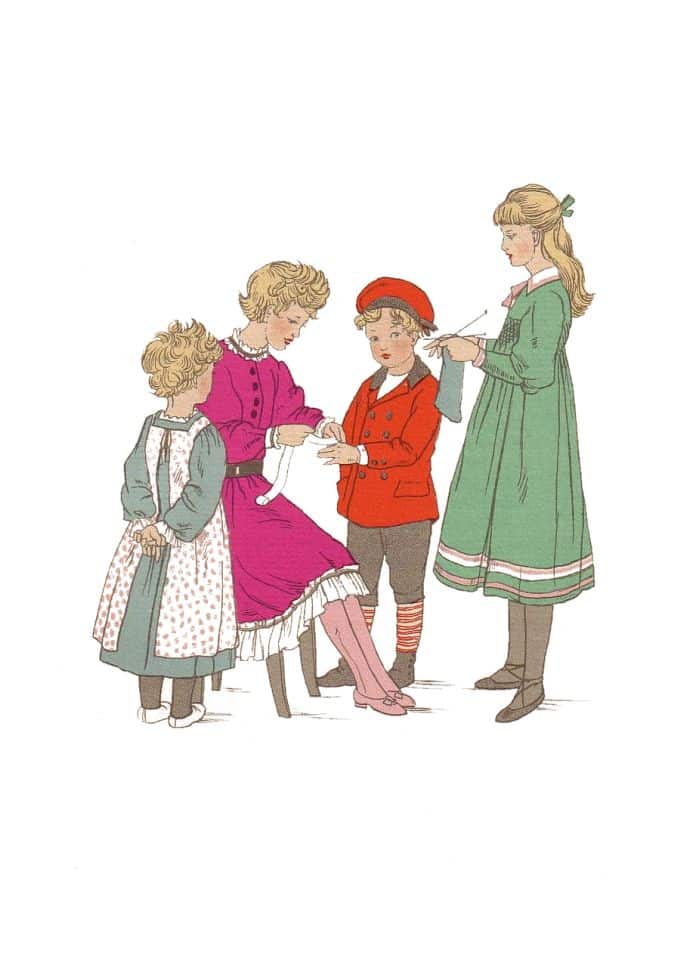
The overskirt of moist of these dresses was made in one with the bodice. Then a separate skirt was worn beneath that.
A small bustle pad support helped hold the back skirt shape.
The bodice neckline was higher than in the 1870s and often featured a small stand neck sometimes frill trimmed.
The frilling or pleating was repeated on other parts of the dress especially on cuffs and the skirt.
Mostly sleeves were straight and slim but some styles had large balloon heads with A straight forearm.
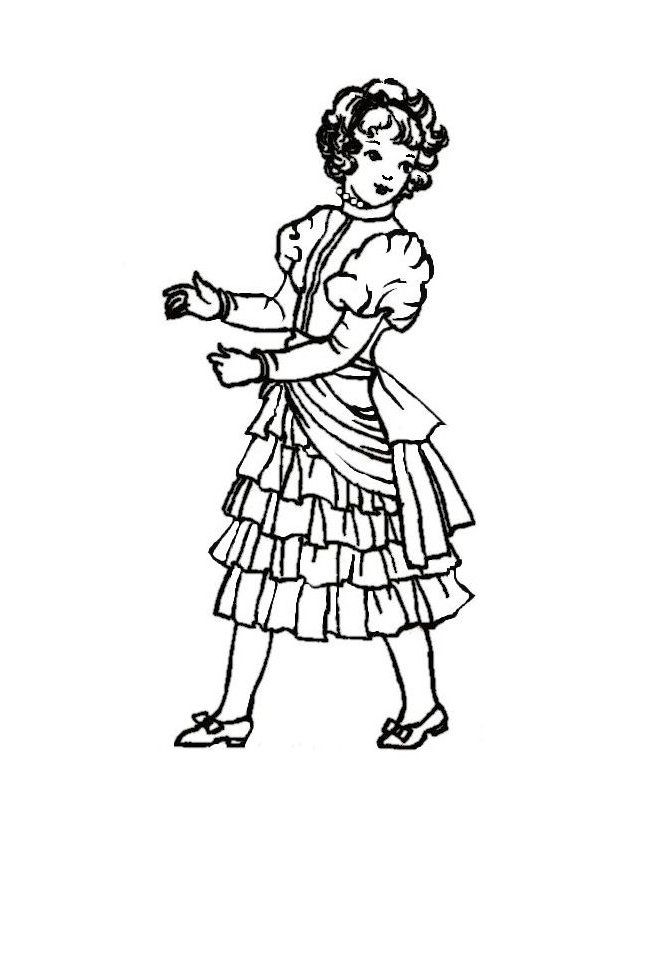
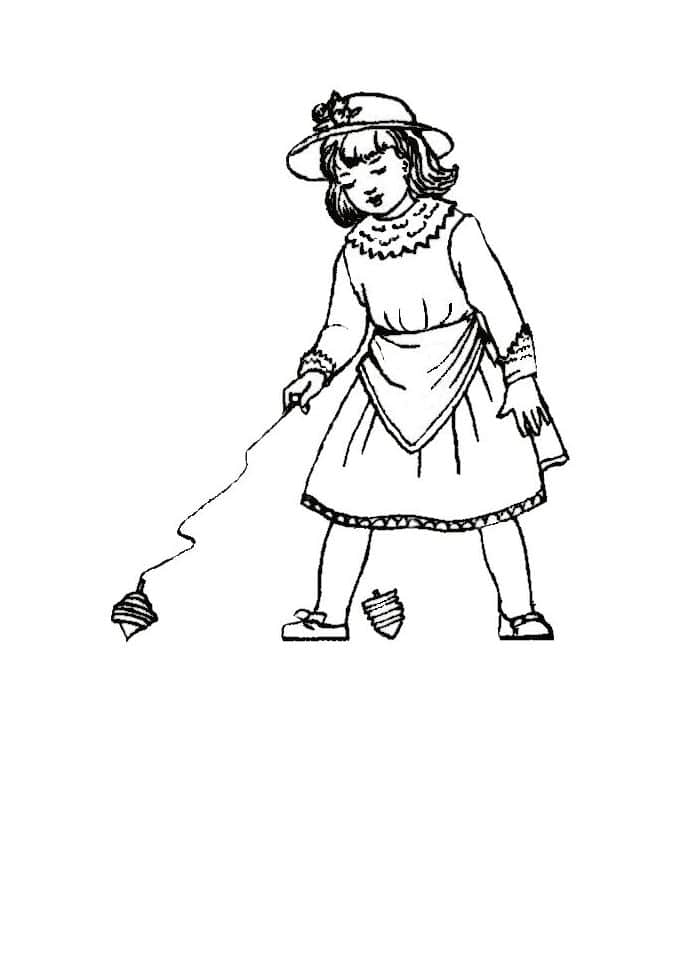
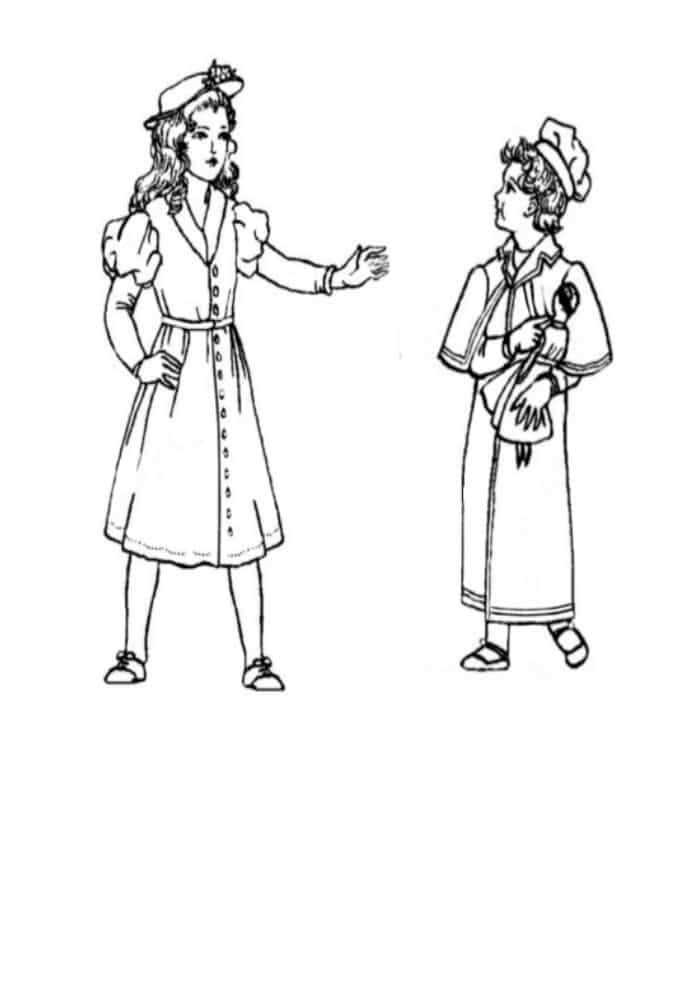
As the decade passed, young girls wore the bodice more loosely with bloused overhang. To create contrast, structured pleated skirts were a popular look with this loose top.
All girl's hairstyles had a heavy fringe and heats varied from floppy mobcap/tam styles to small crowned wide brimmed hats.
Colouring in Picture of Late Victorian Children's Clothes 1890 to 1900
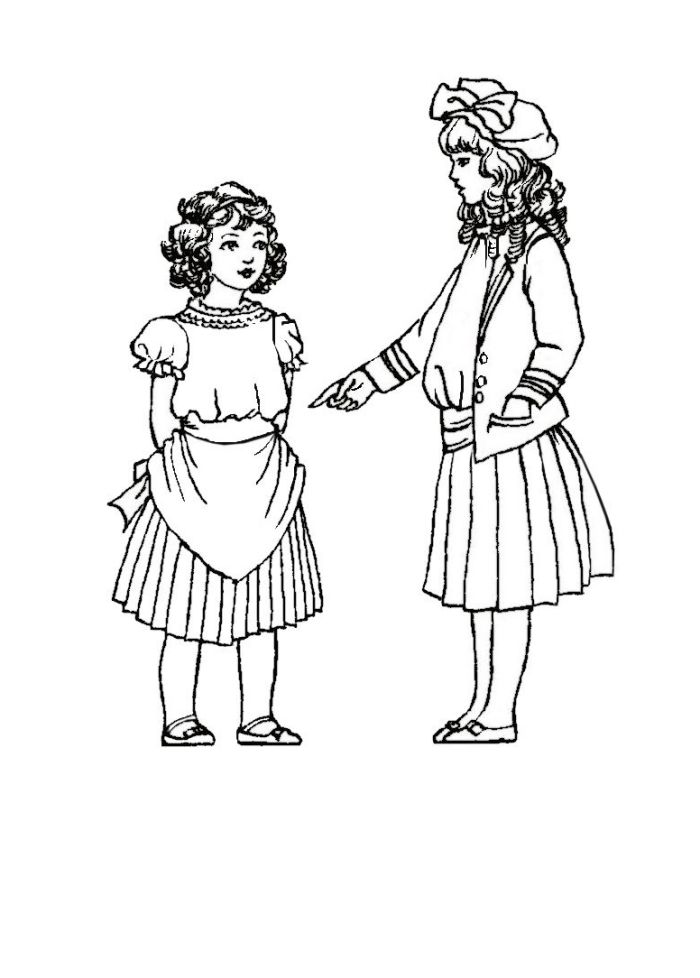
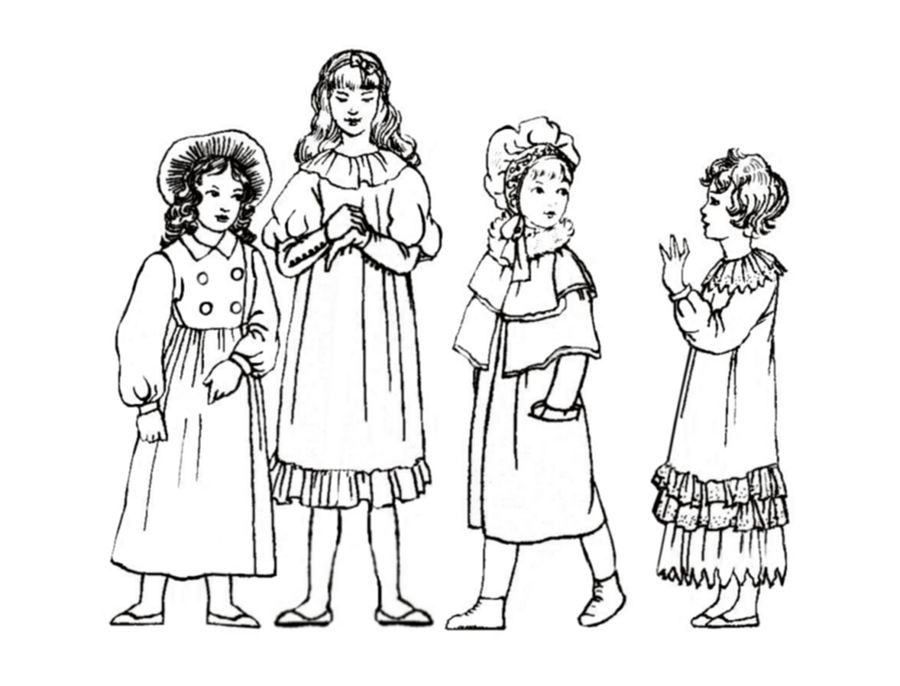
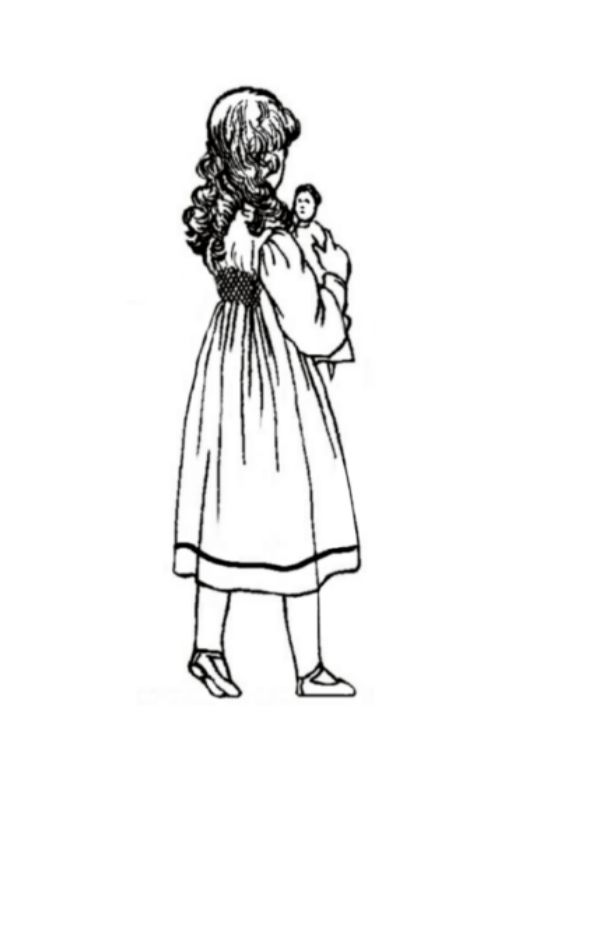
By 1890 girls wore the bodice more loosely settling at the low waist. It was worn with bloused overhang atop a structured pleated skirt. Skirt lengths fluctuated from knee to ankle with the smallest girls wearing dresses almost to the ankle.
The children's bustle had disappeared and high-waisted or high-yoked dresses became fashionable. They were often worn with coats with highwayman layers of capes at shoulder level.
Smock styles set the next 'smart' look and were made in often unsuitable fabrics like velvet in rich dark colours like bottle green, red, claret, black and ultramarine blue.
For a couple of years short hair was fashionable but long hair was soon revived. Long hair symbolised feminine grace.
The newest bonnet style had a band and a gathered mob cap effect at the crown.
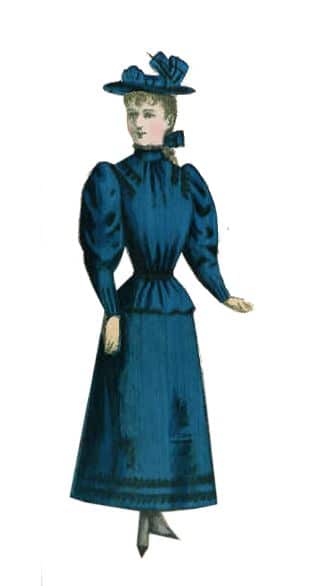
Edwardian Children's Costume 1900 to 1910
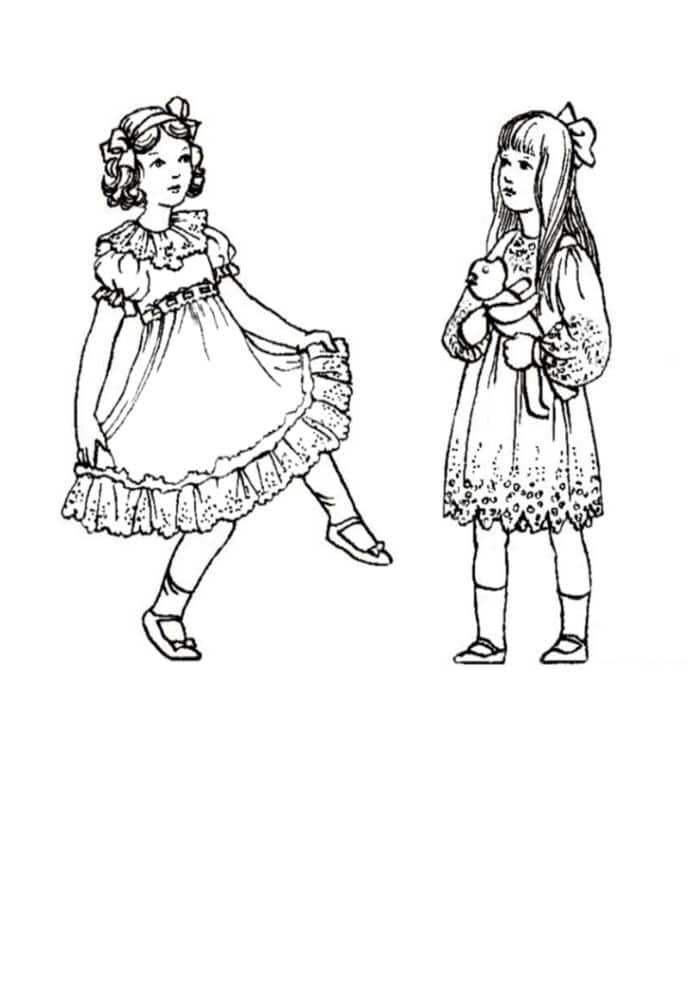
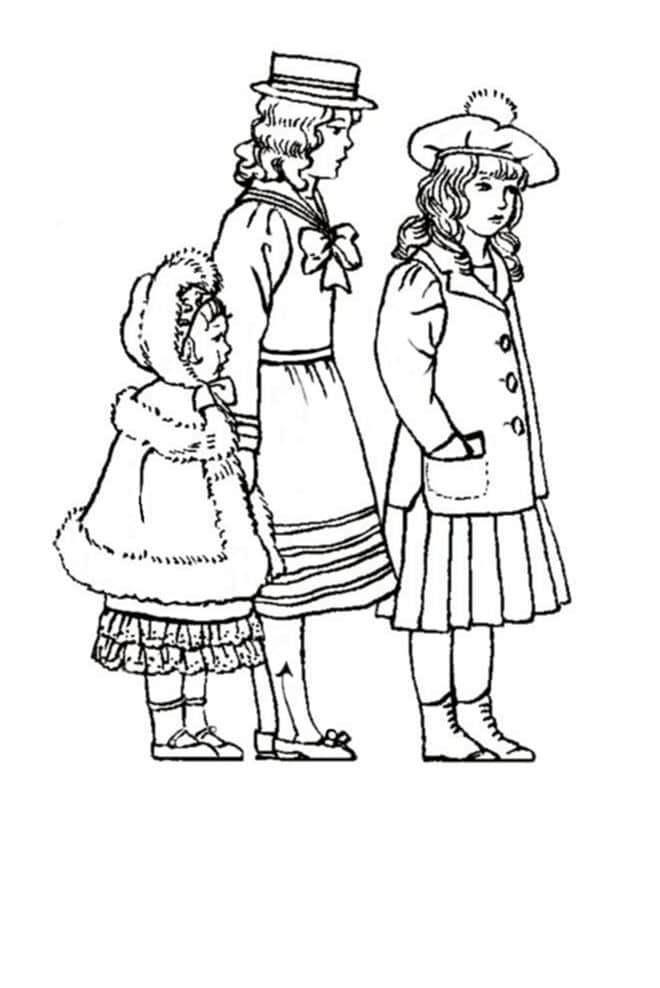
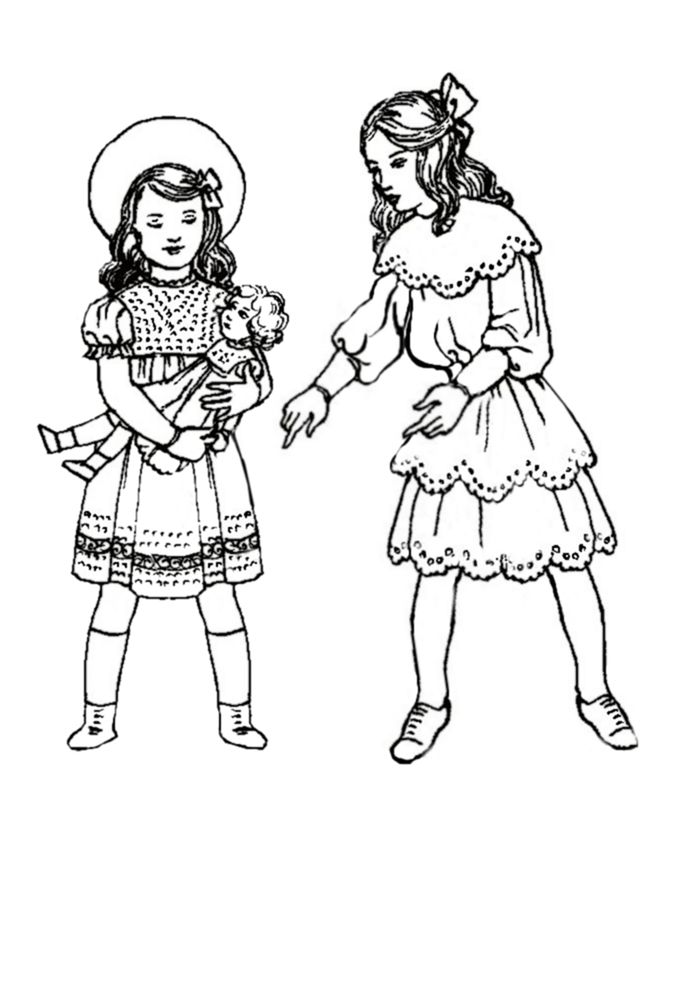
Styles for Edwardian girls at the start of the century look remarkably like those of 1800.
Pale cream, white, ivory, and softer daintier lighter fabrics take over from the heavy plush and thick materials popular in the 1890s.
Voile silk and dotted Swiss muslin were used for the main dress.
Self coloured embroidery on the main fabric was complimented by pastel toned and sugar almond coloured sashes.
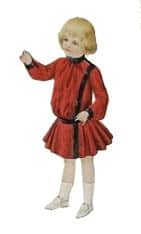
Sashes of lemon, pale mauve, pink and aquamarine all created look so familiar to us from a 100 years before.
Short sleeves began to be seen on small girl's dresses. Frills and deep embroidered hemlines, cape collars or yokes gave opportunity for decorated areas. For outdoor wear girls often wore straw boater hats.
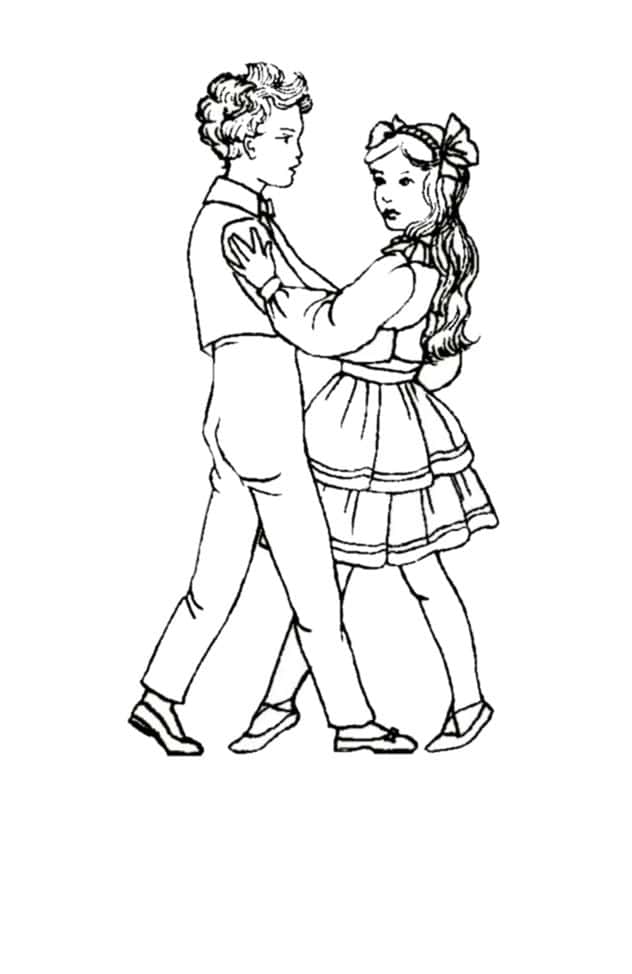

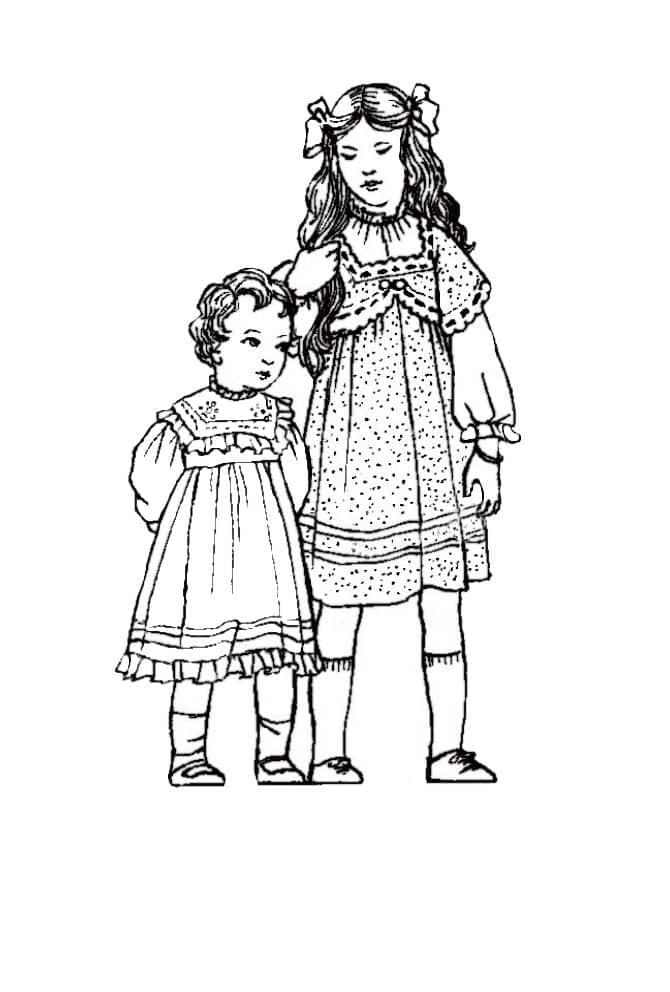
From 1910 older girls were wearing softer colours and only small girls wore whites or creams. The younger children often wore styles following yoked smocks, but older girls wore their sashes at waist level.
By contrast after 1910 streamlined pleated navy gym tunics (centre image), drill dresses or sailor looks became the fashion for schoolgirls of the day.
Very large cape collars were worn over coloured slips. Sleeves were fuller at the wrist than they had been since the crinoline era and sometimes the fullness was gathered into a deep 5 inch cuff or was elasticated as a frill.
Bows were used to lift the hair and keep it organised into a centre parting. Coloured ribbons of all types were sometimes arranged with elastic to create coiffure effects.
Three quarter length socks almost reached to the knee.
Colouring in Pictures of Children's Clothing 1910-1920
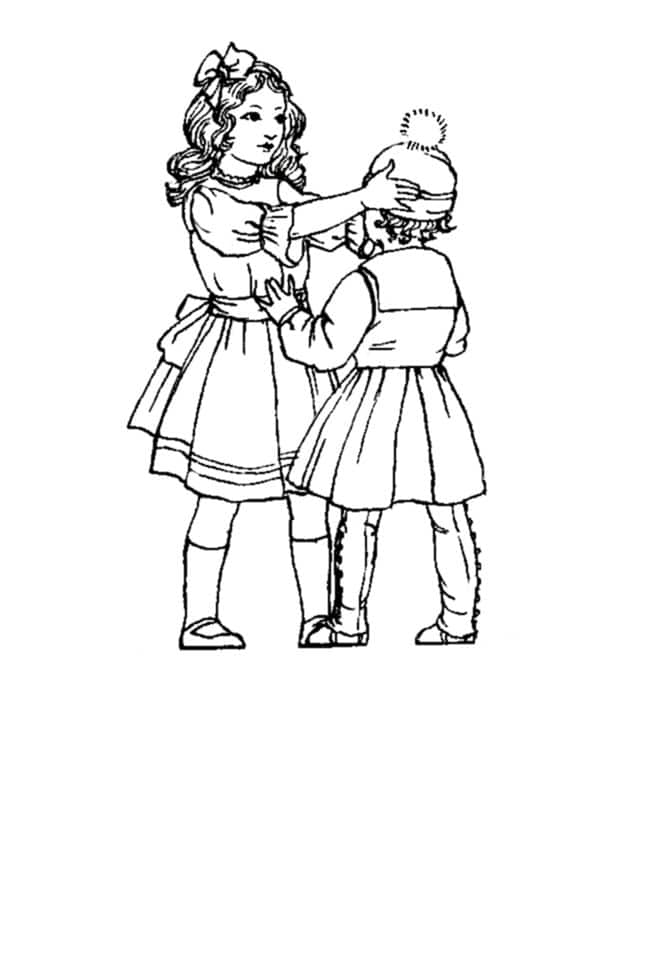

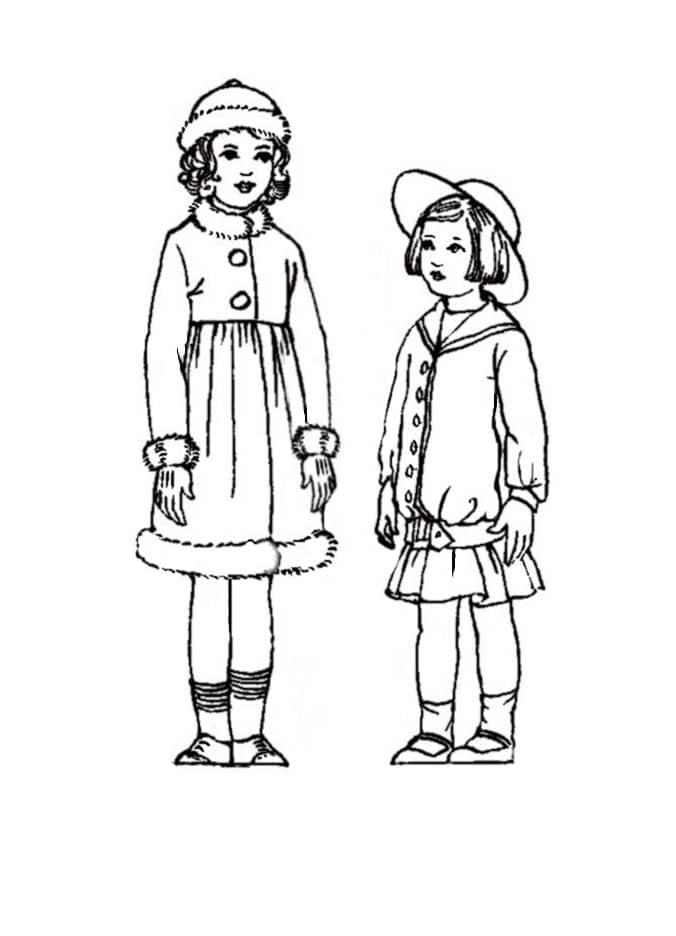
After 1910 colour was less restrictive and children wore a wide range of brighter colours which were much daintier than the gaudy new aniline colours of the mid Victorian era. Patterned and gingham check fabrics replaced wispy muslins.

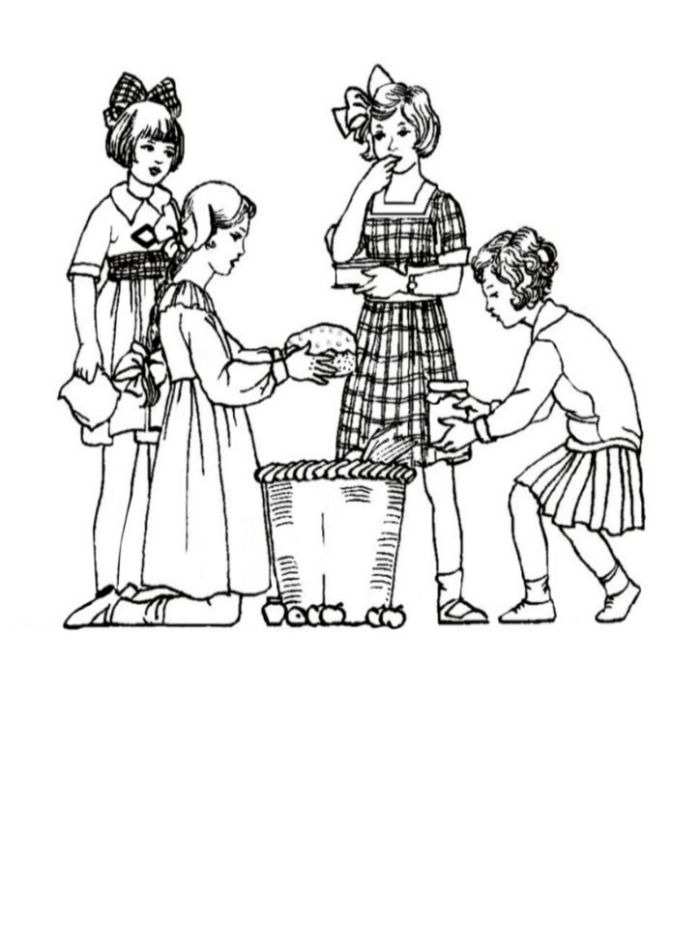
The yoke dropped to the waist and by 1914 dropped even further to the thighs for a few years.
Socks began to shorten to the ankle. The ribbon became a very important hair accessory to decorate the almost universal short hairstyle of girls around 1920. Some ribbons were excessively wide at 6 or 5 inches wide and the need for a hat was eliminated as the head was decorated.
Children also began to wear knitted jerseys and knitted dresses a sign that the 20th century had really arrived.
Victorian Childrens Clothes - These thumbnails enlarge when clicked and print off as an A4 image with a little room for handwriting.
This Children's Costume Drawing and Fashion Page Updated Sept 2023
